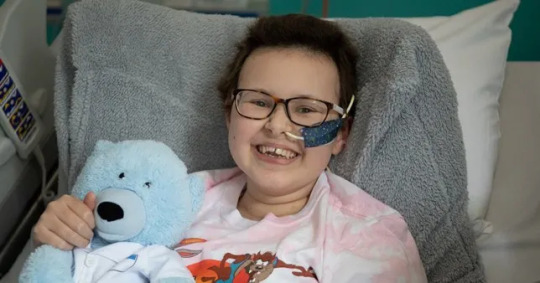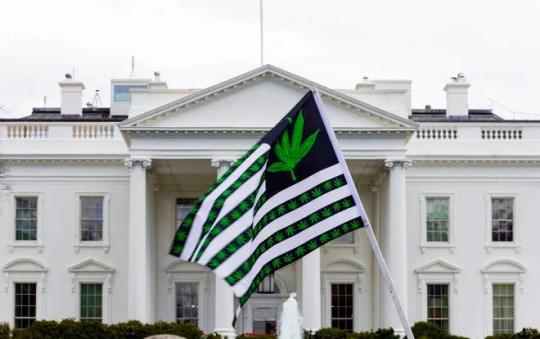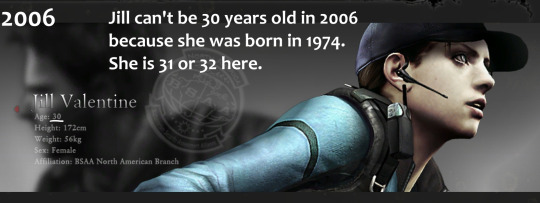#July/September 2009
Text
My life stages have lined up weirdly neatly with the decades, so that the 1990s were the years of pre-school, the 2000s were the years of first school and middle school, the 2010s were the years of high school and university, and so far the 2020s have been the years of employment.
#approximately#started school jan 2000#started high school september 2009#graduated uni july 2018#started my current job november 2019#predicting that i change jobs towards the end of 2029#that would fit the pattern
18 notes
·
View notes
Text
The Best News of Last Year - 2023 Edition
Welcome to our special edition newsletter recapping the best news from the past year. I've picked one highlight from each month to give you a snapshot of 2023. No frills, just straightforward news that mattered. Let's relive the good stuff that made our year shine.
January - London: Girl with incurable cancer recovers after pioneering treatment

A girl’s incurable cancer has been cleared from her body after what scientists have described as the most sophisticated cell engineering to date.
2. February - Utah legislature unanimously passes ban on LGBTQ conversion therapy

The Utah State Legislature has unanimously approved a bill that enshrines into law a ban on LGBTQ conversion therapy.
3. March - First vaccine for honeybees could save billions

The United States Department of Agriculture (USDA) has approved the world’s first-ever vaccine intended to address the global decline of honeybees. It will help protect honeybees from American foulbrood, a contagious bacterial disease which can destroy entire colonies.
4. April - Fungi discovered that can eat plastic in just 140 days

Australian scientists have successfully used backyard mould to break down one of the world's most stubborn plastics — a discovery they hope could ease the burden of the global recycling crisis within years.
5. May - Ocean Cleanup removes 200,000th kilogram of plastic from the Pacific Ocean

The Dutch offshore restoration project, Ocean Cleanup, says it has reached a milestone. The organization's plastic catching efforts have now fished more than 200,000 kilograms of plastic out of the Pacific Ocean, Ocean Cleanup said on Twitter.
6. June - U.S. judge blocks Florida ban on care for trans minors in narrow ruling, says ‘gender identity is real’

A federal judge temporarily blocked portions of a new Florida law that bans transgender minors from receiving puberty blockers, ruling Tuesday that the state has no rational basis for denying patients treatment.
7. July - World’s largest Phosphate deposit discovered in Norway

A massive underground deposit of high-grade phosphate rock in Norway, pitched as the world’s largest, is big enough to satisfy world demand for fertilisers, solar panels and electric car batteries over the next 50 years, according to the company exploiting the resource.
8. August - Successful room temperature ambient-pressure magnetic levitation of LK-99

If the claim by Sukbae Lee and Ji-Hoon Kim of South Korea’s Quantum Energy Research Centre holds up, the material could usher in all sorts of technological marvels, such as levitating vehicles and perfectly efficient electrical grids.
9. September - World’s 1st drug to regrow teeth enters clinical trials

The ability to regrow your own teeth could be just around the corner. A team of scientists, led by a Japanese pharmaceutical startup, are getting set to start human trials on a new drug that has successfully grown new teeth in animal test subjects.
10. October - Nobel Prize goes to scientists behind mRNA Covid vaccines

The Nobel Prize in Physiology or Medicine has been awarded to a pair of scientists who developed the technology that led to the mRNA Covid vaccines. Professors Katalin Kariko and Drew Weissman will share the prize.
11. November - No cases of cancer caused by HPV in Norwegian 25-year olds, the first cohort to be mass vaccinated for HPV.
Last year there were zero cases of cervical cancer in the group that was vaccinated in 2009 against the HPV virus, which can cause the cancer in women.
12. December - President Biden announces he’s pardoning all convictions of federal marijuana possession

President Joe Biden announced Friday he's issuing a federal pardon to every American who has used marijuana in the past, including those who were never arrested or prosecuted.
------
And there you have it – a year's worth of uplifting news! I hope these positive stories brought a bit of joy to your inbox. As I wrap up this special edition, I want to thank all my supporters!
Buy me a coffee ❤️
Merry Christmas and Happy New Year!
6K notes
·
View notes
Text

I miss her.
I wish I could tell her that two prescriptions and someone to talk through things with would enable her to do anything she wanted before it was too late. I wish I could tell her how gorgeous she is. I wish I could tell her her bras are too small 😅 I wish I could tell her that she didn't have to be afraid and alone all the time. I wish I could tell her the reason why she couldn't keep up and breathe, and that there were things she could do about it and that she could be strong and fit anyway, and those two prescriptions would help her do it.
I wish I could make all of her problems go away, because I'm exhausting very possible way I can find to get rid of my problems now but with little result.
#my life#mental health#body image#disability#MCAS#ME/CFS#ADHD#photos of me#my og#photos are from 2009 (17) to summer 2015 (23) before my major symptoms appeared#major physical symptoms at least#my mental health was already rocky in the first pic and had been since always it just worsened very gradually#the last two are supposed to be switched tho oops#july comes before september
1 note
·
View note
Text
Johnny Cash - Hurt
2002
"Hurt" is a song by American industrial rock band Nine Inch Nails from their second studio album, The Downward Spiral (1994), written by Trent Reznor. It was released on April 17, 1995, as a promotional single from the album. The song received a Grammy Award nomination for Best Rock Song in 1996.
In 2002, Johnny Cash covered "Hurt" for his final album during his lifetime, to commercial and critical acclaim. Reznor praised Cash's interpretation of the song for its "sincerity and meaning", going so far as to say "that song isn't mine anymore". The single contains a cover of Depeche Mode's "Personal Jesus" as a B-side.
The music video features images from Cash's life, and was named the best video of the year by the Grammy Awards and CMA Awards, and the best video of all time by NME in July 2011.
When the video was filmed in February 2003, Cash was 71 years old and had serious health problems. His frailty is clearly evident in the video. He died seven months later, on September 12.
The Johnny Cash cover was given the Country Music Association award for "Single of the Year" in 2003. It ranked as CMT's top video for 2003, No. 1 on CMT's 100 Greatest Country Music Videos the following year (and again in 2008), and No. 1 on the Top 40 Most Memorable Music Videos on MuchMoreMusic's Listed in October 2007. As of March 2016, the single occupies the number nine spot on Rate Your Music's Top Singles of the 2000s. The song is also Cash's sole chart entry on the Billboard Modern Rock Tracks chart, where it hit No. 33 in 2003. In June 2009, the song was voted No. 1 in UpVenue's Top 10 Best Music Covers.
"Hurt" was nominated for six awards at the 2003 MTV Video Music Awards, winning for Best Cinematography. With the video, Johnny Cash became the oldest artist ever nominated for an MTV Video Music Award.
The music video won the 2004 Grammy Award for Best Short Form Music Video.
In a 2014 survey conducted by the BBC the UK public voted the Johnny Cash version the second greatest cover version (of any song) of all time.
"Hurt" received a total of 76,3% yes votes!
youtube
2K notes
·
View notes
Text





















May 24, 2024 is the 20th anniversary of Reborn!
Shonen Jump covers primarily featuring the series:
June 7, 2004, Issue No. 26 - New serialization
November 8, 2004, Issue No. 48 - 1st volume release
July 4, 2005, Issue No. 29 - 1st anniversary
March 20, 2006, Issue No. 14 - Beginning of the Varia arc
September 11, 2006, Issue No. 39 - TV anime announcement
October 23, 2006, Issue No. 45 - TV anime debut
November 20, 2006, Issue No. 49 - Beginning of Tsuna vs. Xanxus
July 9, 2007, Issue No. 30 - 3rd anniversary
September 10, 2007, Issue No. 39
November 19, 2007, Issue No. 49
February 18, 2008, Issue No. 10 - 18th volume release
July 14, 2008, Issue No. 31 - 4th anniversary
November 3, 2008, Issue No. 47 - 3rd anniversary of TV anime
June 22, 2009, Issue No. 28 - 5th anniversary
October 19, 2009, Issue No. 45 - Reborn Month event
November 2, 2009, Issue No. 47 - Reborn Month event
February 1, 2010, Issue No. 7 - 27th volume release & TV anime 7th season
April 12, 2010, Issue No. 17 - Beginning of the Inheritance arc & REBORN Colore! release
June 14, 2010, Issue No. 26 - 6th anniversary
September 12, 2011, Issue No. 38 - Beginning of the Curse of the Rainbow arc
290 notes
·
View notes
Text
ʏᴀɴᴅᴇʀᴇ ᴄᴇᴏ

✒ ᴍᴏ��ᴇʏ ᴄᴀɴ'ᴛ ʙᴜʏ ʏᴏᴜ
✉ - ʟᴇᴛᴛᴇʀ ꜰʀᴏᴍ ᴀɴᴏɴʏᴍᴏᴜꜱ - ʜᴇʏ ᴛʜᴇʀᴇ! ᴄᴏᴜʟᴅ ʏᴏᴜ ᴡʀɪᴛᴇ ᴀ ʟᴏᴠᴇꜱɪᴄᴋ ᴄᴇᴏ ᴡʜᴇʀᴇ ᴀ ɢɴ ʀᴇᴀᴅᴇʀ ᴡᴏʀᴋꜱ ᴀᴛ ᴀ ᴄᴏꜰꜰᴇᴇ ꜱʜᴏᴘ ʜᴇ ꜰʀᴇQᴜᴇɴᴛꜱ ᴀɴᴅ ɪᴛ ɢᴏᴇꜱ ꜰʀᴏᴍ ᴛʜᴇʀᴇ? (ɪꜰ ʏᴏᴜ ᴅᴏɴ'ᴛ ᴛᴀᴋᴇ ʀᴇQᴜᴇꜱᴛꜱ ʀɴ ᴘʟᴇᴀꜱᴇ ɪɢɴᴏʀᴇ, ʜᴀᴠᴇ ᴀ ɢʀᴇᴀᴛ ᴅᴀʏ/ɴɪɢʜᴛ ♥)
ᴄᴏɴᴛᴇɴᴛ ɪɴᴄʟᴜᴅᴇꜱ: ꜱᴛᴀʟᴋᴇʀɪꜱʜ ʙᴇʜᴀᴠɪᴏʀꜱ, ᴀɢᴇ ɢᴀᴘ (ʀᴇᴀᴅᴇʀ ɪꜱ ɪɴ ᴇᴀʀʟʏ ᴛᴡᴇɴᴛɪᴇꜱ, ᴍɪʟᴀɴ ɪꜱ ɪɴ ʟᴀᴛᴇ 30ꜱ), ᴇᴀᴛɪɴɢ ᴅɪꜱᴏʀᴅᴇʀ (ᴍɪʟᴀɴ), ɪɴꜱᴏᴍɴɪᴀ (ᴍɪʟᴀɴ), ʀᴇᴀᴅᴇʀ ʜᴀꜱ ᴀ ɢɪʀʟꜰʀɪᴇɴᴅ, ᴜɴʜᴇᴀʟᴛʜʏ ʙᴇʜᴀᴠɪᴏʀ (ʟɪᴛᴇʀᴀʟʟʏ), ᴘᴏꜱꜱᴇꜱꜱɪᴠᴇɴᴇꜱꜱ, ɪᴍᴘʟɪᴇᴅ ɴᴇɢʟᴇᴄᴛꜰᴜʟ ᴘᴀʀᴇɴᴛꜱ, ᴛᴇʟʟ ᴍᴇ ɪꜰ ɪ ᴍɪꜱꜱᴇᴅ ᴀɴʏᴛʜɪɴɢ ᴇʟꜱᴇ!
Yandere CEO who first met you at your job in your friend's family bakery. Young, bright, and full of life, wearing a baby blue apron. You eagerly greeted him with a smile, and asked how he was doing. There was nothing forced about your mannerisms, it was all genuinely, purely, you.
Yandere CEO, despite knowing it'll all end up flushed down a toilet, comes in everyday ordering the different pastries you recommend. After his seventh visit, you jokingly ask him if he's got any cavities yet and he blushes. Not that you notice.
Yandere CEO who gathers the courage to talk to you beyond simple good mornings, and responding to your questions of: “How are you Milan?” or “So that'll it be for today, eh?” and stammers out things like, “N- Nice weather today, huh?” and even, “Uh.. How- How long have you been working here for?” It's all simple, nearly no substance, but it's exceptional progress for somebody like him who barely even speaks to his secretaries beyond plain Yes's and No's.
Yandere CEO whose fair face turns a furious red whenever you tease or compliment him, calling him things like adorable and cute. Never has he been called anything like that before. People see him, with his bodybuilder-esque physique and stoic face, with it's fierce features, and are too intimidated to treat him with anything other than with a respect that is borne out of fear.
Yandere CEO who knows this is wrong. He's 38 years old, and you're only what? 23? This is wrong, this is taboo, this is predatory. But his heart can't help but beat furiously for you each time he steps inside the quaint little bakery. Your bright smile, your gentle eyes, your warm voice. You are like the sun, and he is your ever-devoted Icarus, who will crash and burn if he tries to even fly an inch closer.
Yandere CEO who is unable to sleep at night. He's used to this, he's had insomnia since he was a teenager in highschool, but never like this before. Where previously it was paranoia and anxieties that kept sleep at bay now it was you, the scent of pastries and bread, and your warmth.
Yandere CEO who unconsciously starts to act like a teenage girl. Doodling your name in the margins of his paperwork, writing (Name) x Milan over and over again in the empty pages of his journal, which was previously used exclusively for tracking his expenses but was now being used for more personal entries.
July 17, 2009
Today [Name] remembered it was my birthday, and bought me a slice of chocolate cake using his own money. I tried to keep it down, but unfortunately my body is too used to emptying its stomach whenever I eat too much.
September 7, 2009
[Name] asked me if I've been sleeping well recently, and even if I told him I was okay, he still gave me a box of teabags. He told me it helps him sleep at night, and hopes it'll be able to help me too. He's so kind, and too good to me. I can never tell him it's him who's the cause behind these sleepless nights. I think it'll devastate him. Sometimes, I hope it will.
February 13, 2010
[Name] asked me if I was going to buy somebody any pastries for Valentine's Day, and if there's anybody I'm hoping to receive any chocolates from. I wanted to tell him I hoped to receive chocolates from him, but that would be inappropriate. Then he told me he hoped his girlfriend would remember to give him some.
[Name] has a girlfriend.
Yandere CEO who doesn't show up for multiple days after you reveal this to him. He goes back to old habits, the following days occupied by work, work, and work. He sleeps rarely, and wakes up late. He eats even less than he usually does, and forgets to go to the gym.
The only thing that Yandere CEO does outside of that? Pay private investigators to learn as much as possible about you, no matter how dirty or well kept the secret is he will know.
It's unethical, a violation of all your rights, but he thought you two were close. That you were friends. A kind of relationship he barely even knew. All he knows is distant families, cold business partners, and shallow imitations of friendship. He thought you were different, you were so real, but if he didn't even know you had a girlfriend, then what else was he unaware of?
Yandere CEO whose father calls him, and tells him his secretaries have told him about how he's been acting, and advises him to take a break. Perhaps he should try to hit the dating scene? He'll have to get married eventually, and he's not getting any younger.
Yandere CEO who goes to the blind dates his mother arranges for him. Daughters of her friends, sometimes even granddaughters. Women who are sometimes a decade younger than him. Women who are his age. He never told his parents he was gay, and now he has to suffer through this.
Yandere CEO who is thinking of canceling the date on the spot when she takes him to a familiar bakery, the familiar bell rings as the door swings open and you're still there, wearing your baby blue apron, and the polite smile you flashed his date immediately widens when you see him.
Yandere CEO who freezes up, and then stammers out a greeting, face flushed. His date, who has so far only experienced the cold and stoic front he puts on, is surprised that what has broken down the stone walls he's put up is the cute, young, male baker, who has a bright grin on his face.
“Milan!” You practically chirp, “It's been so long, where have you been man?”
You were wondering where he was? You missed him? You missed him? Milan? He couldn't believe his ears, he felt like he could faint.
Milan clears his throat, averting his grey eyes away from you, and avoiding Carrie's burning gaze.
“I have been preoccupied with work,” He explains, it's not a lie, he's just exaggerating how much work there was for him when it was basically just him doing paperwork and attending meetings every once in a while, “I apologize if my absence has bothered you…”
You chuckle, “I'm just glad to see you again.” Milan can't help the small smile that forms on his face, but he restrains it from widening into a grin. He's in front of Carrie, a friend but at the same time a business partner, a marriage prospect, an unwelcome intruder into what could've been a moment between you two.
You glance at Carrie as if remembering that she was here, “Ah, sorry, you must've been confused on how I know him, but I'm a friend of Milan,” You smile kindly at her, “Name's [Name] [L/N], nice to meet you!”
Carrie forces a polite smile on her face, “A pleasure,” Her eyes are filled with a cold fury, though Milan knows it's not directed to you, “My name is Carolyn, Carolyn Deveuraux. However, you may call me Carrie.”
Milan fakes a cough, “Mhm, anyways.. I'd like to have the usual… and Carrie you'll have..?”
She hums, “I'll have a cinnabon.”
You glance between the two, noticing the obvious tension between them, “Oookay, I'll have that prepared for you two in a jiffy,” Milan hands you his card, and savors the slight brush of your fingers, before your warmth is teared away and you slide it back to him when you're done.
He glares at Carrie for scaring you away, but she doesn't even look at him, her eyes are fixed on you. Milan wants to gouge her eyes out, she doesn't even deserve to look at you. Not when she barely knows you. Not like him, who knows every single thing about you that his money can buy for him.
You head into the back to prepare the goods, and Carrie goes back outside where there are tables and chairs. She sits on one, and crosses her arms. Milan settles on the one across from her, posture straight, arms on the table, eyes… decidedly not looking at Carrie.
“So, you and that man… [Name], was it?” Milan nods, she continues, “You know each other, do you?” She taps one carefully manicured nail against the arm of the chair. Tap, tap, tap.
Milan does not simply know [Name], he practically lives underneath the younger man's skin, but instead of verbalizing this he nods once more, “We have known each other for two years.”
“Hm,” Her eyes narrow, they are blue, like ice, “ And how old is [Name]?”
“Twenty-four years old,” Milan tells her, “He had just gotten out of college when we first met.” His eyes trail to the window into the bakery, you still haven't emerged. Why were you taking so long?
“Does he know?” Carrie’s tone is sharp and frigid. Milan glances at her, if he is not careful then he could be caught up in an inescapable storm.
“He does not,” Milan admits, “And I'd prefer to keep it that way.” You still have your girlfriend, and he's content with your secrets and the stolen pictures.
Carrie glares at him, “Why him? Is it his mind? His personality? Or is he simply a pretty boy you like to ogle at?” She's angry, and Milan, for his lack of proper socialization, has been taught to read people, every single shift in expression or body language has a hidden meaning, can tell this fury stems from something personal.
“That is none of your business,” Milan had known Carrie for a while now, since his 30th birthday party where his father invited all his associates, and Lewis Deveuraux had brought his 28 year old daughter Carolyn, but they were never friends so much as allies in the cutthroat world of capitalism, and she was crossing a line.
“I can tell your father.”
“Have you ever heard of the saying, ‘Snitches get stitches’, Carolyn?” Milan asks, “You tell him, and I'll be doing so much more than giving you stitches.”
Carrie doesn't even flinch, “Not much you can do when stripped of your position at your father's company,” She doesn't get a chance to continue, not when you arrive with a tray carrying the warm pastries. You set the plates down, as well as the complementary coffee.
“Here you go…” You glance between the two of them, “It's been nice seeing you again Milan,” You smile at Carrie, “Great to meet you too, Carrie, hope to see you around some more.”
Milan digs a nail into the skin of his palm hard enough to draw blood, if only to stop himself from punching that smirk on Carrie's face off, “Thank you, [Name],” Her voice is pleasant, light and airy, “It was a pleasure to meet a… friend of Milan today.”
“Same here,” You grin. You wave goodbye to the both of them, then head back into the bakery.
Carrie's polite smile is gone as soon as you're out of the vicinity, “Let's talk about this later,” She reaches out and places a well-manicured hand on top of Milan's larger one, and her lips curl up, “For now, enjoy the treats your little crush has made for us.”
Yandere CEO, who since that reunion has started coming back more often. Happy to finally be able to bask in your presence again, thoughts of your girlfriend are dashed from his mind when he saw your smile again after two months of being deprived of it.
The only downside? Carrie is there as well. Chatting you up, using her charm to lower your guard down. She's a snake, or a wolf in sheep's clothing. Yandere CEO knows she's trying to break you two apart, but he won't let her.
Yandere CEO who can't stand watching you smile at her, keeping up with her bright mind in ways he knew you could but had never seen before. He didn't know it was possible, but he's become even more enraptured. Handsome with not only a good personality, but also intelligent. God, you were perfect.
Yandere CEO is able to himself with an endurance he didn't even know he possessed. He's not used to the rage that has been gathering inside him, but it's not that similar to managing his fear and paranoia. He can't do anything to Carrie, not when you two have practically become the best of friends.
Yandere CEO who decides that he can't let himself fall behind, he was here first you know. He's known you for two years while Carrie was only for a few weeks. He musters up the confidence he often uses in meeting rooms, trying to look suave and cool, but instead making you laugh.
“Haha… you're seriously so adorable Milan,” You tease, “What're you acting so serious for?”
After that, Yandere CEO decides to just act how he did before, it's clearly more effective as you've even invited him to eat with you in the park near the bakery during your lunch hours. Something you haven't done in the two whole years you've known each other.
He realizes that in a sense, you are like him. Despite his stoicness, and your expressive features, his assertive aura, with your laid back vibe, both of you have an appreciation for genuine people. It makes his heart beat faster, for some inexplicable reason.
Yandere CEO who listens to you attentively as you start opening up to him more about your life. Your struggles with paying off college debt, your inability to land a higher paying job, and how you don't have enough money to pay for your rent. He already knows about all of this, but is happy nonetheless to be able to give you a comforting hug or pat on the back. One time, you actually cried and he got to feel the warmth of your tears as they raced down your face, they soaked into the skin of his palm as he wiped them away and offered you words of comfort.
Yandere CEO who abides by the law of equivalent exchange, and opens up to you more as well. He's heard before that the more imperfect you make yourself out to be, the more attractive you were for it was a sign of humanity. So what's more human than sharing his past as a bullied fat kid, and the whiplash he got once he had bulked up and attracted admirers like they were flies? Maybe it's the insomnia, the social anxiety, and the knowledge that he's surrounded by shallow people. Whatever it is, it works.
Yandere CEO who has started to feel genuinely close to you. Where before, it was akin to a celebrity having to deal with an awkward yet starstruck fan, now it felt like you two were old friends having a good time together. This is the first time he's had a relationship like this and he'd rather have his company go bankrupt and end up homeless on the streets than lose it.
September 12, 2010
[Name] is not meant for me, he is young, full of potential, and with a girl that he loves. But he tempts me with his warm eyes, beautiful smile, and those kind words of his that has had me wrapped around his finger since the very first day I met him.
It is wrong, it is dirty. I am too old, too broken, worn out like a hand me down toy. However I cannot help myself. He is like the sun, bright and comforting, yet he burns me so.
[Name]
[Name]
[Name]
Even just writing his name has me weak at the knees, it makes me feel alive. Like I can face the day without wanting to retreat back to my bed and refusing to get out till I am dragged by my feet. Just the idea of being able to catch a glimpse at him, gives me the energy to get up and do a marathon.
[Name] is too charming for his own good. He’s such a sweet boy, not knowing how much he tempts me to do such despicable things every single time I see him talking to customers or laughing with Carrie. He doesn’t know, he doesn’t know, he doesn’t know.
I should be leaving him alone, and never speaking to him again. He is fine, he is perfect, he is like God. But I am nothing but a filthy sinner who shouldn’t even be within his sights. Better kept away, far far away. But I want nothing more than to touch him, to hold his feet in my filthy hands and press my cold lips to it. His foot alone is worth more than my entire career. His life? Priceless.
However if I were to distance myself from him again, I’d become a shell. No better than a living corpse. My father and mother would be concerned for the business, and they’d keep on trying to figure out why I’m in such a state, till they eventually trace it all back to [Name], and I can’t have that. I don’t want them knowing about him. It is bad enough Carrie knows. But my own parents?
I cannot accept that. I will not share him. They would take him away from me like they took away everything else good that could’ve happened to me by being my parents and birthing into the life that I’ve led. His warmth would be engulfed in their cold gazes and harsh words, and soon he would be no better than I am, and that cannot happen.
He may not be meant for me, but I will make sure nobody else can have him.
Even that girlfriend of his.

☏ - ᴠᴏɪᴄᴇᴍᴀɪʟ: ᴍʀ. ꜱᴀɢᴇ ᴡᴏᴜʟᴅ ʟɪᴋᴇ ᴛᴏ ʀᴇᴍɪɴᴅ ʏᴏᴜ ᴀʟʟ ᴛʜᴀᴛ ʀᴇQᴜᴇꜱᴛꜱ ᴀʀᴇ ᴏᴘᴇɴ, ɪꜰ ʏᴏᴜ'ᴅ ʟɪᴋᴇ ᴛᴏ ꜱᴇᴇ ᴍᴏʀᴇ ᴄᴏɴᴛᴇɴᴛ ʟɪᴋᴇ ᴛʜɪꜱ.
#yandere male#yandere x you#yandere x reader#yandere oc#yandere imagines#male yandere#male reader#x reader#yandere#yandere male x reader#Milan Balter#sorry i've been dead guys :)#school's been hectic#ya boy had to do a some public speaking (T_T)#anyways this was very fun#he's so pathetic#i love him
930 notes
·
View notes
Text
Spencer Reid A-Z Masterlist
these are written as a story with each letter being a new chapter. I recommend reading in chronological order for story purposes, but these could also work as one shots.
unless explicitly stated, all my fics ignore anything related to jeid, and in my universe, maeve simply does not exist. i do like the idea that spencer and ethan may have had a romance in college
the following events are removed from canon: anything related to a jeid romance, maeve (i just can't have reader and spencer break up for her character to have her moment)
the following events are what i believe to have happened before this timeline began: spencer and ethan had a small (non-sexual) romance in college which is the real reason why they hadn't spoken in years, spencer is a virgin, lila archer events did occur, however i do not believe he had real feelings for her, he was just doing his job (i do think he enjoyed the kiss though, because who wouldn't)
I’ve put them in a timeline and they are further categorized by emojis
Have recommendations? Visit my Spencer Reid A-Z Recommendations to submit your ideas!
key:
🧸- fluff
🔥- smut
❤️🩹- angst
🕰️- coming soon
2008
january
03: you join the BAU (age 24)
july
07: a is for About Time 🧸
23: b is for Boy Genius? 🧸
august
09: c is for Case by Case 🧸
25: d is for Diana🧸
september
12: e is for Even Guys Like Me? 🧸❤️🩹
15: f is for First Date 🧸
october
03: g is for Girlfriend 🧸
12: Spencer’s 27th Birthday
31: h is for Hold my Hand 🧸
november
07: i is for I knew it! 🧸
12: Henry LaMontagne is born
17: j is for Just So You Know… 🧸
december
05: k is for Kissing Isn’t Enough 🔥
14: l is for Lover Boy 🧸
22: m is for Merry Christmas 🧸
2009
january
01: n is for New Years 🕰️
26: o is for🕰️
february
02: p is for Pretty Boy 🕰️
11: jj returns from maternity leave
18: q is for Quiet 🕰️
march
09: r is for Reid? 🕰️
26: s is for Sitter 🕰️
april
10: t is for Two Time 🕰️
19: u is for
may
07: v is for
26: w is for
june
5: x is for
29: y is for
july
16: z is for
#spencer reid#spencer reid fluff#spencer reid x y/n#spencer reid x fem!reader#spencer reid x reader#spencer reid imagine#spencer reid fanfiction#spencer reid x bau!reader#spencer reid x you#spencer reid fic#criminal minds#criminal minds fanfiction#criminal minds x reader#spencer reid smut#spencer reid x y/n smut#spencer x reader#criminal minds fanfic#criminal minds smut#spencereidluver#spencer reid a-z
683 notes
·
View notes
Text










HAPPY 42ND BIRTHDAY TO HRH THE PRINCE OF WALES, WILLIAM ARTHUR PHILIP LOUIS ♡
On 21 June 1982, Prince William was born to Diana and Charles, then known as Prince and Princess of Wales in St Mary's Hospital, London, at at 21:03 BST. He was born during the reign of his paternal grandmother Elizabeth II and was the first child born to a Prince and Princess of Wales since Prince John's birth in July 1905.
The little prince's name was announced on 28 June as William Arthur Philip Louis. Wills was christened in the Music Room of Buckingham Palace by the then Archbishop of Canterbury, Robert Runcie, on 4 August.
William studied at Jane Mynors' nursery school and Wetherby School in London before joining Ludgrove. He was subsequently admitted to Eton College, studying geography, biology, and history at the A-level.
The Prince undertook a gap year taking part in British Army training exercises in Belize, working on English dairy farms, and as part of the Raleigh International programme in southern Chile, William worked for ten weeks on local construction projects and taught English.
In 2001, William enrolled at the University of St Andrews, initially to study Art History but then changed his field of study to Geography with the support of the love of his life Catherine Elizabeth Middleton who he met while at school.
Will and Cat fell in love during their time at uni, and married at Westminster Abbey on 29 April 2011. The couple have three adorable cupcakes Prince George (b.2013), Princess Charlotte (b.2015) and Prince Louis (b.2018). The family of five divide time between their official residence, Kensington Palace and their two private residences - Amner Hall & Adelaide Cottage.
After university, William trained at the Royal Military Academy Sandhurst. In 2008, he graduated from the Royal Air Force College Cranwell and joined the RAF Search and Rescue Force in early 2009. He transferred to RAF Valley, Anglesey, to receive training on the Sea King search and rescue helicopter, which made him the first member of the British royal family since Henry VII to live in Wales.
During his active career as a Search and Rescue Pilot, William conducted 156 search and rescue operations, which resulted in 149 people being rescued. He then served as a full-time pilot with the East Anglian Air Ambulance starting in July 2015, donating his full salary to the EAAA charity.
Working with all branches of the military, he holds the ranks of Lieutenant Colonel in the Army, Commander in the Navy and Wing Commander in the Air-Force
Upon their wedding, WillCat became HRH The Duke and Duchess of Cambridge, The Earl and Countess of Strathearn and Baron and Lady Carrickfergus. He became the heir apparent on 8 September 2022, receiving the titles of the Duke of Cornwall & The Duke of Rothesay. William & Catherine were made The Prince and Princess of Wales by Kimg Charles on 9 September 2022. Additionally, William also became the Prince & High Steward of Scotland, Earl of Chester, Earl of Carrick, Lord of the Isles, and Baron Renfrew.
As well as undertaking royal duties in support of The King, both in the UK and overseas, The Prince devotes his time supporting a number of charitable causes and organisations with some of his key areas of interest being Mental health, Conservation, Homelessness, Sports and Emergency Workers.
He has undertaken several overseas trips representing the monarch, covering a wide array of countries like Australia, Canada, Namibia, Malaysia, South Africa, Tanzania, Pakistan Italy, Jordan, Kuwait, France, India, The Bahamas, Belize, Afghanistan etc ; He is also is also a founder of various initiatives like United For Wildlife, Heads Together, Earthshot and Homewards.
#happy birthday william ❤️#william's 42nd birthday#prince of wales#the prince of wales#prince william#william wales.#william prince of wales#british royal family#british royals#royals#royalty#brf#royal#british royalty#catherine middleton#kate middleton#duchess of cambridge#2024 wales birthdays#prince george#princess charlotte#prince louis#royaltyedit#royalty gifs#royalty edit#royaltygifs#my gifs#21062024
166 notes
·
View notes
Text
A little theory about birthdays
I'm bored, so it's time to share my silly thoughts about when Chris, Jill and Wesker's birthdays are. The exact date of birth of Resident Evil characters has never been officially stated, but thanks to information from the games, assumptions can be made.

Be careful, there are a lot of numbers here that you can get confused about. So take your time reading this article.
So, what do we know? Officially, in re1 (1998), Chris is 25 years old, and Wesker is 38. And Jill, btw, is 23 years old. Officially, their birth years are: 1973, 1960 and 1974 (date from her grave). Let's remember these dates, they will be very useful to us ahead.
I won't use Jill's age confusion from re5 because she has the wrong dates there.


And also I won't take Chris' age info from re1, because it was already changed in re5, and now the old info contradicts the new info. Example: he is 32 years old in August-September 2006 instead of 33 because his birthday is not yet due, but he WAS 25 years old in July 1998. This is a contradiction that I will ignore. Therefore, I will calculate Jill's birthday by re1-re3, Chris's by re5, and Wesker's by re1 and re5.
Let's start with Jill.

Jill has 1974 listed, although based on her age (23) in re1-re3, it should be 1975. I tend to assume that she just hasn't had a birthday yet, so she hasn't had time to turn 24 yet. The events of re1-re3 take place between July and October, so her birthday must be after. Probably from October to December.
Now Chris.


Chris's age in re5 (2009) is 35 years old. However, 1973-35=1974, not 1973. This means that in re5 he is a year younger than he should be. It also means that it is his birthday this year, and that he has yet to turn 36. The events of re5 take place in March, so his birthday could be anytime between March 8 and December 31. However… let's remember Lost in Nightmares, the events of that DLC take place (presumably) in late August or early September 2006. It states that Chris is 32 years old, which again doesn't ring true, he should be 33. This means that even at the time of August-September, Chris still didn't have a birthday, meaning that the interval has shortened, and that his birthday could actually be from September to December.
Wesker.

He is officially 48 years old in re5 (2009). But Wesker was born in 1960, which means… 2009-1960=49. His birthday hasn't had time to come yet either. However, in July 1998, he had already managed to turn 38, so that means his birthday is between March and July.
Result: Chris's official birthday is from September to December, Jill's is from October to December, and Wesker's is from March to July.
#resident evil#rebhfun#chris redfield#albert wesker#jill valentine#resident evil 5#resident evil theory#cenori's long posts about RE
148 notes
·
View notes
Text
Frequently Asked Questions from the last two days:
There have been a lot of questions shot my way lately, and I'm a little overwhelmed. Sorry if I've missed anything.
Recurring things:
"I was going to do NaNo this year, but now I guess I won't!" NO! Writing is great! Just don't use their website! There are other online trackers if you don't feel like using excel. There are other online writing communities. I recommend 4theWords. I recommend finding out what your former ML is doing or asking your local library/bookstore if they're hosting anything.
"I didn't know there was an organization. What did they even do?" They had a website that tracked your progress and hosted an online forum of writers also doing NaNo. They also hosted the Young Writer's Program, which mostly ran out of schools and had more direction than the adult version. They also supported the MLs, who hosted in person write-ins, kick off parties, and occasionally a pot luck Thanksgiving dinner. Also, the sponsors of NaNoWriMo would often give discounts to winners. This is how everyone I know in real life affords Scrivner.
"Why is this time stamped from July?" A NaNoWriMo timeline of events: In 2023, there was a grooming scandal. It was ignored for months and then handled poorly. Later that year (*correction: it was in 2024), in response to the grooming scandal, they offered the MLs (Municipal Liaisons) new contracts that required them to moderate their regional forums, accept all liability for behavior at their in-person write-ins and their regional forums, and threw in an anti-defamation clause for good measure. In July of 2024, they posted on tumblr about "Ethical Ways to use AI." My screenshots result from that debacle. In September, they put out their official AI policy, and here we are.
"Why are you canceling them now and not over the grooming scandal?" My history with NaNoWriMo: I started doing NaNo in 2009. I stopped using the site in 2019, when the website was so glitchy that it wouldn't keep track of my word count, but I kept doing the challenge without them. I deleted my account in 2023 when the ML scandal broke. I forgot to unfollow them on Tumblr, because they don't post much. When I saw their July AI post, I commented "Boooo!" and unfollowed them. They promptly slid into my DMs.
103 notes
·
View notes
Note
What do you make of the moment when Kate shrugged William's hand on a Christmas show in 2019? The sugars use this to show how they actually hate each other, but I've always thought Kate just reacted immediately because they never did PDA and she was caught by surprise, as in to say "what are you doing? we're working"
I've been following the BRF since the Sussex drama, so I don't have decades the reflect on, but from what I've seen, it really seemed there was a no PDA rule. They also appeared much stuffy, even towards each other, with Kate standing straighter, making sure she was walking behind William, often keeping her hands in front of her as if to protect herself. But the last years, the seem more at ease in public, allowing some hands on the back here and there. And I've actually been wondering if H&M overdoing it with the PDA meant the BRF could actually relax a bit and allow some touching without looking unprofessional.
There isn’t a “no PDA” rule. The rule is that everyone is expected to be professional at work. And PDA - over the top PDA like the Sussexes - is not professional behavior in any industry, in any profession, in any country in the world.
William and Kate are affectionate and playful with each other. They always have been, long before Meghan had Harry in her claws:

Before their engagement:
L - Graduating St. Andrews in 2005
C - Saying hello at polo in 2006
R - Paparazzi catching them making out. Date unknown, suspected sometime 2009 (based on William's hair).

Newlyweds:
L - Canada, July 2011
C - Edinburgh, July 2011
R - London Olympics 2012

Early Parenthood:
L - Christmas Walk, December 2013
C - Commonwealth Games in Glasgow, July 2014
R - Rugby World Cup, September 2015

Before the Love Bomb:
L - Hiking in India, April 2016 (there's a well-known story from royal reporters on the India trip that William and Kate were close and affectionate until they spotted the reporters and photographers. Once they saw the royal rota, they immediately separated and became more formal/professional.)
C - Private family ski trip, February 2016
R - Canada, September 2016

Before Meghan made her official debut with Harry and the BRF:
L - Heads Together awareness event, February 2017
R - Wimbledon Men's Final, July 2017
And no, I didn't see "the incident" as Kate shrugging off William's hand because it was PDA. I see that moment as Kate adjusting her position in her seat and William briefly touching her. If you watch the clip, you'll notice that Kate's whole body wiggles; her shoulders, her trunk, and her legs. William just happened to touch her in that same moment. If she was shrugging him off, if she was recoiling from his touch, only her shoulder would have moved. It was a harmless, normal moment that happens to everyone.
Others may see it differently, and that's fine.
Harry and Meghan overdoing it with the PDA didn't open any doors for anyone to be more affectionate or show more affection. All they did was highlight the difference between working professionals who a) know they're on the job, b) know their roles for the job, and c) know that their job is bigger than their individual needs and people who think their love and togetherness is more important than the job.
61 notes
·
View notes
Text
IMPORTANT CRISES THAT ARE BEING IGNORED BY THE WORLD
[ we already are aware about palestine, NOT just gaza so i will refrain from mentioning anything here regarding it ]
these crises will not follow any specific order but i will be numbering them for the sake of proper structure.
i also did my best to find reliable and accurate information. please do not start hating me or questioning my efforts if i have mentioned something wrong or incorrect. instead you can correct me politely. additionally, if there are any crisis that i have missed out on, bring it to my awareness.
i am not going to be including all details but some major highlights so as to be able to keep ourselves updated of atleast the surface level knowledge (so i will try)
reblog and include (or highlight what needs to be excluded) any details that would serve in the best interest of this post.
1. TAMIL EELAM
sri lanka is an island historically inhabited by tamils, sinhalese, muslims, and other communities. the tamil nation is concentrated in the northeast. the muslim community generally speaks tamil. the majority of the country's sinhalese population lives in the southern part of the island and are buddhist.
following independence from britain, the sinhalese ruling class began to build an ethnocratic nation-state that entrenched sinhala-buddhist supremacy. tamil workers' rights were denied in the new nation-state, while tamil students were refused equal access to education. tamil people protested peacefully, but sri lanka responded with arrests and massacres.
in july 1983, the worst anti-tamil pogroms swept the island: tamil people were hunted in the streets, pulled out of their homes, and killed while sri lankan police watched on. In six days, 4000 tamils were killed. government ministers led mobs and targeted tamil homes in areas where tamils and sinhalese both lived, amounting to what the international commission of jurists labelled an act of genocide.
sri lanka booted the UN and international press from the country before relaunching its war against the tamil people in 2006. the state used banned chemical weapons like white phosphorous on civilians. a UN report estimates that 75,000 tamil civilians perished from september 2008-May 2009 alone. ground sources place the number much higher and estimate that over 120,000 people were killed in the final stages of the war.
nothing was spared. hospitals and religious buildings, full of the sick and wounded, were routinely bombed. the armed forces shelled food distribution lines and near International red cross ships picking up wounded civilians from beaches. even the government's own "no-fire zones," packed with thousands of civilians, were indiscriminately attacked from the ground and sky.
for the tamils, the last stages of the war fit into a broader pattern of sri lanka's post-colonial state-building project: a protracted genocide involving massacres, economic embargoes, indiscriminate bombings, discriminatory policies, and the dispossession of tamil lands. tamils fear their political identity, as a distinct group of peoples, a nation, will be dismantled and reduced to a scattered minority across the island.
12 years after the genocide, the sri lankan armed forces maintain complete control through a military occupation of the tamil homeland. five of the seven regional headquarters of the army are entrenched in the tamil homeland, with over 100,000 soldiers maintaining an environment of harassment and surveillance over the tamil people. like kashmir and palestine, the tamil homeland remains one of the most militarized places in the world.
HOW TO HELP
2. ROHINGYA
in august 2017, armed attacks, massive scale violence, and serious human rights violations forced thousands of rohingya to flee their homes in myanmar’s rakhine state. many walked for days through jungles and undertook dangerous sea journeys across the bay of bengal to reach safety in bangladesh. now, more than 960,000 people have found safety in bangladesh with a majority living in the cox bazar’s region - home to the world’s largest refugee camp. the united nations has described the rohingya as “the most persecuted minority in the world.”
the rohingya are a muslim ethnic minority group who have lived for centuries in predominantly buddhist myanmar - formerly known as burma. despite living in myanmar for many generations, the rohingya are not recognized as an official ethnic group and have been denied citizenship since 1982, making them the world’s largest stateless population.
as a stateless population, rohingya families are denied basic rights and protection and are extremely vulnerable to exploitation, sexual and gender-based violence (SGBV) and abuse.
the rohingya have suffered decades of violence, discrimination and persecution in myanmar. their largest exodus began in august 2017 after a massive wave of violence broke out in myanmar’s rakhine state, forcing more than 742,000 people - half of them children - to seek refuge in bangladesh. entire villages were burned to the ground, thousands of families were killed or separated and massive human rights violations were reported.
more than 1 million rohingya refugees have fled violence in myanmar in successive waves of displacement since the 1990s. now, more than 960,000 rohingya refugees are living in bangladesh with a majority settled in and around kutupalong and nayapara refugee camps in bangladesh’s cox’s bazar region — some of the largest and most densely populated camps in the world.
more than half of all rohingya refugees in bangladesh (52 percent) are children, while 51 percent are comprised of women and girls. the current refugee population accounts for one-third of the total population in the cox’s bazar region, making support to host communities essential for peaceful coexistence.
since 2021, to decongest the 33 camps in cox’s bazar, nearly 30,000 refugees have been relocated to bhasan char island by the government of bangladesh. while protection services and humanitarian assistance have been scaled up on the island, significant gaps remain in service delivery and the sustainability of critical assistance.
rohingya refugees have also sought refuge in other neighboring countries like thailand (92,000) and India (21,000), with smaller numbers settling in indonesia, nepal and other countries across the region.
armed clashes across myanmar have continued to trigger displacement, bringing the total number of internally displaced people (IDP) within the country to more than 1.8 million — including 1.5 million of whom have been internally displaced since february 2021.
as of december 2023, however, a new issue arose. the indonesian navy has pushed back a boat carrying rohingya refugees as it approached the coast of aceh amid resentment among some residents about a sudden increase in boat arrivals. the military said the coastguard first detected the wooden vessel entering indonesian waters on wednesday, before the navy ship KRI bontang-907 located the boat about 63 nautical miles (117km) off aceh on the northwestern tip of the archipelago and drove it out, “ensuring that the boat did not return to indonesian waters,” the navy said in a statement posted in its website.
military spokesperson nugraha gumilar said it was not known how many people were on board. they are suspected to be rohingya, a mostly muslim minority from myanmar who were forced into neighbouring bangladesh by a brutal military crackdown in 2017 that is now the subject of a genocide investigation.
more than 1,500 rohingya refugees have landed in indonesia on barely sea-worthy wooden boats since november, according to data from the united nations refugee agency (UNHCR), and the sudden jump in arrivals has aroused growing hostility among people in aceh.
indonesia has appealed to the international community for help and intensified patrols of its waters, promising to crack down on suspected human traffickers it says are involved in the latest wave of boat arrivals.
on wednesday, a mob of students stormed the basement of a local community hall in banda aceh, the acehnese capital, where about 137 rohingya were taking shelter and called for the group to be deported.
many of the refugees are in poor health after weeks at sea usually with insufficient supplies of food and water.
the UNHCR said it was “deeply disturbed to see a mob attack on a site sheltering vulnerable refugee families”.
indonesia, although not a signatory to the 1951 UN convention on refugees, was once known for providing a safe haven to the rohingya even as neighbouring malaysia and thailand pushed them away.
but the mood has soured this year, especially in aceh, where some residents claim the rohingya behave badly and create a burden on society.
muslims make up nearly 90 percent of indonesia’s 277 million people, and aceh is the only state in the archipelago to follow islamic law.
the growing hostility towards the rohingya has put pressure on president joko widodo’s government to take action.
“this is not an easy issue, this is an issue with enormous challenges,” foreign minister retno marsudi told reporters.
HOW TO HELP
3. MANIPUR
on may 3, members of the kuki and naga tribes, who inhabit manipur's hills and are regarded as scheduled tribes, or india's most disadvantaged groups, launched a protest against the possible extension of their benefits to the dominant meiteis.
meiteis account for half of manipur's population and extending limited affirmative action quotas to them would mean they would get a share in education and government jobs reserved for kukis and nagas.
meiteis have traditionally lived in manipur's more prosperous valley region that makes up 10% of the state's area. they have also had better access to employment and economic opportunities.
nagas and kukis live in the poorly developed hills.
the development imbalance favouring the valley over the hills has been a point of contention and rivalry between the ethnic groups.
the groups coexisted peacefully until unrelated events in recent months exposed old faultlines.
manipur shares a nearly 400-km (250-mile) border with myanmar and the coup there in 2021 pushed thousands of refugees into the indian state.
kukis share ethnic lineage with myanmar’s chin tribe and meiteis feared they would be outnumbered by the arrival of the refugees.
separately, the state government in february launched a drive to evict tribal communities from forests in the hills, saying they had encroached on government land, sparking anger among tribal people that they were being forced out of their homes.
"it has been building up for a long time, in some ways unseen and some ways quite openly, but the government was not paying attention," said pradip phanjoubam, editor of the imphal review of arts and politics.
although the first outburst of violence was put down by mid-may, sporadic reprisal attacks began within days.
both the meiteis and kukis are known to be flush with arms, including automatic weapons either stolen from the state police or sourced from across the border in myanmar.
new delhi has held talks with senior myanmar leaders to help control armed groups that operate from across the border but this is yet to produce results.
kuki and meitei groups also refused to join a peace panel formed by the federal government due to differences over names included in the panel.
the indian army and federal paramilitary forces in the state cannot act independently and are legally bound to work with state police and authorities, who analysts say are also divided along ethnic lines.
also, kukis accuse the bharatiya janata party-ruled state government's chief minister biren singh, a meitei, of complicity and inaction, and have sought his removal. singh denies the accusations.
HOW TO HELP
4. HAWA'II ( MAUI )
maui wildfires of 2023, a series of wildfires that burned parts of the island of maui in the U.S. state of hawaii in august 2023. the fires, which began on august 8, struck hardest the historic resort town of lahaina, on maui’s western peninsula, reducing most of the town to ash and ruins. 98 people were killed in lahaina by the smoke and flames or by drowning, making the wildfire one of the world’s deadliest on record. almost 3,000 structures were reported to have been either damaged or destroyed by the fire. in addition to the fires on maui, a series of less devastating wildfires burned parts of the island of hawaii starting on august 9.
while local and state government officials have hesitated to identify a specific cause of the wildfires (in general, uncontrolled fires in a forest, grassland, brushland, or cropland) as of august 17, some evidence suggests that sparks produced by a downed power line may have touched off at least one of the fires. meteorologists and climate researchers noted that the fires were likely to have been the product of several intersecting factors. the fires occurred at the height of hawaii’s dry season (which lasts from april to october). their severity was exacerbated by the presence of el nino—that is, the development of unusually warm ocean waters in the central and eastern tropical pacific ocean. el niño brings increased rainfall to south america’s west coast but brings drought conditions to the hawaiian islands. indeed, the interval of june to august 2023 was a period of worsening drought on maui and in other parts of hawaii. as the drought increased in severity, it dried vegetation, much of it made up of large tracts of fire-prone invasive shrubs and grasses.
in addition, the pool of warm water in the tropical pacific kept fueling hurricane dora, a powerful tropical cyclone that had formed off the western coast of mexico on august 2. dora passed some 1,100 km (about 700 miles) south of the hawaiian islands during the week of august 8, the day the fires began, which created a substantial difference in atmospheric pressure between the storm and a high-pressure system located north of the islands. that pressure difference drew high winds southward and funneled them into the centre of the tropical cyclone, which helped intensify and spread the wildfires. wind speeds reached as high as 107.8 km (67 miles) per hour on maui and up to 132 km (82 miles) per hour on the island of hawaii.
some researchers have noted that climate change may have played a part in worsening the wildfires’ severity. increases in global and regional surface temperatures due to ongoing global warming are thought to have caused grasses and other vegetation to dry out faster than usual. in addition, studies that considered trends in hawaii’s rainfall indicated that some 90 percent of the state had experienced at least some decline in overall rainfall between 1920 and 2012 and that rainfall amounts at higher elevations had fallen by more than 30 percent between 1990 and 2015 during the state’s wet season (november to march). in addition, the replacement of native vegetation with crops over the last century has affected local climate conditions, primarily in accessible areas in several parts of the state of hawaii, including near sections of coastline and in maui’s central valley—the sites of the island’s wildfires.
the fire near lahaina, a municipality of 12,702 people, began as a small brush fire just beyond the town’s eastern outskirts in the early morning hours of august 8. although local officials considered it to have been contained by mid-morning, the fire flared up during mid-afternoon, forcing officials to close lahaina’s bypass road. driven by the high winds, the fire then moved downslope into the town, and it spread quickly between the parched grassy landscape and the town’s predominantly wooden buildings, generating an immense wall of black smoke. within 15 minutes, the fire had spread to the centre of the town, burning the area between the town’s two primary access roads, which prompted additional road closures that hindered evacuation. the process of alerting residents to the danger was severely hampered by the toppling of several telephone and electric power poles in the area by high winds earlier that day, which had cut power needed for wireless services and telephone lines used for 911 emergency communication. as the fire grew, it became so intense that it melted pipes delivering water to lahaina’s residences, which reduced the town’s overall water pressure and thus inhibited the fire department’s ability to contain the wildfire.
ny 5:30 PM large areas of lahaina, which included tracts of residences and the town’s central business district, were on fire as exploding gasoline tanks in vehicles and filling stations contributed to the conflagration. since emergency services had no way to alert people through their mobile devices, the fire caught many residents by surprise, forcing some to flee in haste while trapping others in their homes. many of those who fled became boxed in by fire, smoke, and road closures; some sheltered in place, whereas others sought refuge in the pacific ocean, clinging to docks, pilings, seawalls, and other infrastructure. by 7:00 PM the fire had reached the harbour, and boats caught fire from the mix of wind-whipped flames and flying embers, causing their fuel tanks to explode. although the fire continued to burn in lahaina throughout the night, U.S. coast guard boats arriving offshore were able to evacuate several people trapped along the coast.
during the morning of august 9 the winds abated enough to allow firefighting crews, helicopters, and other resources to begin to make their way into lahaina, where they found a grayed landscape of ruined buildings and burned-out vehicles. officials reported that the lahaina fire had been 80 percent contained by august 10 and that it had burned nearly 890 hectares (about 2,200 acres) by august 14. maui’s other wildfires, which included the pulehu/kihei fire in maui’s central valley and the upcountry/kula fire along the slopes of the island’s eastern peninsula, were less severe, resulting in far fewer damaged homes and other structures and no reports of serious injuries or deaths. similarly, on the island of hawaii, fires scorched some 600 hectares (about 1,500 acres) of ranchland in the north and south kohala sections of the island, but no injuries were reported.
even as the fires began to spread on maui, government officials started to issue disaster declarations to fund firefighting efforts, rescues, and recovery. hawaii’s lieutenant governor, sylvia luke, issued an emergency declaration during mid-afternoon of august 8, which was followed later that evening by the activation of hawaii’s national guard. the following day, as reports of the unfolding disaster in lahaina reached the outside world, the U.S. federal emergency management agency (FEMA) authorized payments to fire victims, and U.S. pres. joe biden promised that “all available federal assets on the Islands” would assist in relief efforts. such efforts had increased by august 16, aided by state and federal agencies (including the U.S. Army, which provided logistical support and assisted in road clearing) and private charter flights that delivered donations of food and other supplies. In the aftermath of the wildfires, thousands of displaced maui residents were taken to shelters and evacuation centres on the island, which included hotels abandoned by tourists who had been evacuated to other islands or to the U.S. mainland.
HOW TO HELP
5. KURDISTAN
kurds have never achieved nation-state status, making kurdistan a non-governmental region and one of the largest stateless nations in the world. portions of the region are recognized by two countries: iran, where the province of kordestan lies; and northern iraq, site of the autonomous region known as kurdistan regional government (KRG) or iraqi kurdistan.
the turkish government claims to be conducting operations against the kurdistan worker's party (PKK) - a kurdish rebel organization that is outlawed by the state. through the use of airstrikes, the turkish military is hitting targets across the region and pushing deeper into southern kurdistan, launching ground operations from the military bases that it controls in the area.
a consequence of this encroachment into southern kurdistan is that civilians are being hit by turkish drones. those who are being hit are not just fighters but also ordinary kurdish civilian. innocent lives are also being lost when those who are hit succumb to their injuries. turkey justifies such acts under the pretext of fighting the PKK a rationale that it has used repeatedly to justify other military incursions. is this conflict new? absolutely not. what is new is the response to these operations. In previous decades, the turkish state could get away with indiscriminate bombing and military incursions as long as its justification centered on fighting terrorism. this justification was, after all, what other state actors operating in the region would use to rationalize military incursions against those deemed state enemies. no longer are there just people from kurdish diasporas across the world calling out the turkish state for its disregard for international law, but also from non-kurds. even at the administrative level of the united states government, officials are no longer believing the rhetoric that the turkish state uses to justify its military incisions. there will be no peace in kurdistan until turkey withdraws. there will be no peace for victims until turkey is held accountable for its criminal actions now and in the past. and as long as these atrocities are left without a response by international state actors and multilateral organizations such as the united nations and NATO, turkey will continue to commit crimes against kurds, including kurdish civilians.
HOW TO HELP
6. YEMEN
yemen is in the middle of a complex humanitarian crisis driven by a brutal civil war. indiscriminate attacks and chronic shortages of medical staff and supplies have led to the closure of many of yemen's healthcare facilities. more than 4.5 million people have been displaced since the war started in 2014. qith an estimated 21 million currently in need of humanitarian assistance.
collapsed health system- warring factions have extensively damaged public infrastructure, notably health facilities. since the saudi-led coalition (SLC) imposed a blockade in 2015, import restrictions and soaring inflation have severely limited yemenis' access to healthcare and essential services. the blockade has led to the cessation of salaries for many of the 50,000 health workers within the country, compelling them to exit the public health system in search of alternative income sources.
disease- due to the ongoing war, obtaining clean water, waste disposal, and accessing medical care have become even more challenging for the people. coupled with limited access to vaccinations, this heightened vulnerability has left yemenis susceptible to preventable diseases and emerging epidemics. the impact of the COVID-19 pandemic was particularly severe, with yemen having one of the lowest vaccination rates globally in 2021. in 2017, a cholera outbreak led to 101,475 patients being admitted to hospital. the same year, cases of diphtheria emerged, a disease largely eradicated in most countries due to systematic childhood vaccinations.
trauma- continual fighting and indiscriminate attacks have affected the ability to provide trauma care, which remains a vital responsibility of hospitals in the area. teams in hospitals near the frontlines routinely react to mass-casualty incidents and continually strive to enhance their capacity year-round to address the frequent arrival of war-wounded and other trauma patients.
malnutrition- yemen is grappling with alarming rates of malnutrition. widespread food insecurity and limited access to essential healthcare services leave many children vulnerable to infectious diseases. Inflation exacerbates the situation, making it progressively challenging for yemeni families to provide nourishment for their children and cover the expenses of transporting them to hospitals.
it has been troubled by civil wars for decades, but the current conflict intensified in march 2015 when a saudi-led coalition intervened on behalf of the internationally recognised government against houthi rebels aligned with the former president ali abdullah saleh. the war is widely regarded as having turned a poor country into a humanitarian catastrophe. riyadh expected its air power, backed by regional coalition including the united arab emirates, could defeat the houthi insurgency in a matter of months. instead some reports suggest nearly 100,000 people have died. others put the death toll much lower, but fighting this year alone has displaced 250,000 people. there are more than 30 active front lines. a total of 80% of the population - more than 24 million people - need assistance and protection, including 10 million who rely on food aid to survive. its roots lie in the arab spring. pro-democracy protesters took to the streets in a bid to force the president, ali abdullah saleh, to end his 33-year rule. he responded with economic concessions but refused to resign. by march 2011, tensions on the streets of the capital city, sana'a, resulted in protesters dying at the hands of the military. following an internationally brokered deal, there was a transfer of power in november to the vice-president, abd rabbu mansour hadi, paving the way for elections in february 2012 - in which he was the only candidate to lead a transitional government. hadi's attempts at constitutional and budget reforms were rejected by houthi rebels from the north. the houthis belong to a small branch of shia muslims known as zaydis. they captured the capital, forcing hadi to flee eventually to riyadh. there is also a strong secessionist movement in the south. arguably too many sides benefit financially from the status quo. united nations officials warned that without more donations, nearly 400 hospitals and health care centers it finances would have to reduce services just as the coronavirus pandemic has surged in yemen. already, food rations have been halved for 8.5 million hungry yemenis, and 10,000 health care workers have lost the united nations payments that for many are their only salary, ms. grande said. since the war began five years ago, pitting the houthis against a government backed by saudi arabia and the united arab emirates, yemenis have endured doomsday after doomsday: relentless airstrikes against hospitals and schools by the saudi-led military coalition using american-made weapons, a severe cholera outbreak, the ever-present threat of famine, a health care system in collapse and now the coronavirus. "yemenis themselves say things are worse today than at any time in their recent history," mr. lowcock said in his appeal to donors, asking "whether the world is prepared to watch yemen fall off the cliff."
HOW TO HELP
7. SYRIA
over 80% of the population in syria is living below the poverty line. that means they make less than $1 a day. more than 11 million people require humanitarian assistance, 5 million of which are children. 93 million people across syria are now food insecure lacking reliable access to a sufficient quantity of affordable, nutritious food. 70% of the population is without regular access to safe drinking water. 6.1 million people have been internally displaced. up to 70% of healthcare professionals have left the country & 50% of hospitals are non-operational. 40% of school infrastructure has been destroyed or damaged.
government and allied forces continued to commit war crimes and other serious violations of international humanitarian law, including indiscriminate attacks and direct attacks on civilians and civilian objects. according to the UN, government forces did not approve around half of their requests to carry out humanitarian missions to:
monitor
assess and accompany aid deliveries,
provide security, logistics and
administrative support.
you may ask, how did the "war" start? even before the conflict began, many syrians were complaining about high unemployment, corruption and a lack of political freedom under president bashar al-assad, who succeeded his father, hafez, after he died in 2000. in march 2011, pro-democracy demonstrations erupted in the southern city of deraa, inspired by uprisings in neighbouring countries against repressive rulers. when the syrian government used deadly force to crush the dissent, protests demanding the president's resignation erupted nationwide.
the unrest spread and the crackdown intensified. opposition supporters took up arms, first to defend themselves and later to rid their areas of security forces. mr assad vowed to crush what he called "foreign-backed terrorism".
the violence rapidly escalated and the country descended into civil war. hundreds of rebel groups sprung up and it did not take long for the conflict to become more than a battle between syrians for or against mr assad. foreign powers began to take sides, sending money, weaponry and fighters, and as the chaos worsened extremist jihadist organisations with their own aims, such as the islamic state (IS) group and al-qaeda, became involved. that deepened concern among the international community who saw them as a major threat. syria's jurds, who want the right of self-government but have not fought mr assad's forces, have added another dimension to the conflict.
the united nations human rights office estimated last year that 306,887 civilians - 1.5% of the total pre-war population - were killed between march 2011 and march 2021 due to the conflict. it is said 143,350 civilian deaths were individually documented by various sources with detailed information, and that a further 163,537 deaths were estimated to have occurred using statistical techniques. at least 27,126 of those estimated to have been killed were children. the then-UN commissioner for human rights, michelle bachelet, stressed that the fatalities were the "direct result of war operations", adding: "this does not include the many, many more civilians who died due to the loss of access to healthcare, to food, to clean water and other essential human rights." the syrian observatory for human rights (SOHR), a UK-based monitoring group with a network of sources on the ground, had documented the deaths of 503,064 people by march 2023. it said at least 162,390 civilians had been killed, with the syrian government and its allies responsible for 139,609 of those deaths. the group estimated that the actual toll from the war was more than 613,400, with an additional 55,000 civilians believed to have died of torture in government-run prisons. another monitoring group, the violations documentation center, which relies on information from activists across the country, had documented 240,215 battle-related deaths, including 145,765 civilians, as of march 2023.
the government's key supporter has been russia while turkey, western powers and several gulf arab states have backed the opposition to varying degrees during the conflict.
russia - which had military bases in syria before the war - launched an air campaign in support of mr assad in 2015 that has been crucial in turning the tide of the war in the government's favour. the russian military says its strikes only target "terrorists" but activists say they regularly kill mainstream rebels and civilians.
the US, UK and France initially armed what they considered "moderate" rebel groups. but they have prioritised non-lethal assistance since jihadists became the dominant force in the armed opposition.
aUS-led global coalition has also carried out air strikes and deployed special forces in syria since 2014 to help an alliance of kurdish and arab militias called the syrian democratic forces (SDF) capture territory once held by IS militants in the north-east and stop the jihadist group rebuilding.
turkey is a major supporter of the opposition, but its focus has been on using rebel factions to contain the kurdish YPG militia that dominates the SDF, accusing it of being an extension of a banned kurdish rebel group in turkey.
turkish troops and allied rebels have seized stretches of territory along syria's northern border and intervened to stop an all-out assault by government forces on the last opposition stronghold of Idlib.
saudi arabia, which is keen to counter iranian influence, armed and financed the rebels at the start of the war. having refused to engage with president assad for more than a decade, it is now discussing how to facilitate syria's "return to the arab fold".
twelve years of war have inflicted immense suffering on the syrian people. in addition to the bloodshed, more than half of syria's pre-war population of 22 million have had to flee their homes. some 6.8 million are internally displaced, with more than two million living in tented camps with limited access to basic services. another 6 million are refugees or asylum-seekers abroad. neighbouring lebanon, jordan and turkey, which are hosting 5.3 million of them, have struggled to cope with one of the largest refugee exoduses in recent history. at the start of 2023, the UN said 15.3 million people inside syria were in need of some form of humanitarian assistance - an all-time high since the war began - and 12 million did not know where their next meal was coming from. the already dire humanitarian situation in north-western syria - the location of the last opposition stronghold - was made significantly worse by the huge earthquake that struck near the turkish city of gaziantep, about 80km (50 miles) from the syrian border, on 6 February 2023. more than 5,900 people were killed across Syria and another 8.8 million were affected, according to the UN. thousands of homes and critical infrastructure were destroyed, leaving many families without food, water and shelter. deliveries of life-saving aid to opposition-held areas were also delayed for days because of what a UN panel described as "shocking" failures by the warring parties as well as the international community. the disaster happened at a time when the prices of food and fuel in syria were already skyrocketing because of runaway inflation and the collapse of its currency, as well as the global crisis exacerbated by the war in ukraine. syria has also been one of the countries in the middle east worst affected by the covid-19 pandemic - although the true extent is not known because of limited testing - and is now also having to deal with a deadly cholera outbreak that was made worse by the earthquake. access to medical care is severely restricted for the sick and injured because only half of the country's hospitals are fully functional. despite their protected status, 601 attacks on at least 400 separate medical facilities had been documented by physicians for human rights as of february 2022, resulting in the deaths of 942 medical personnel. the vast majority of the attacks were blamed on government and russian forces. entire neighbourhoods and vital infrastructure across the country also remain in ruins. UN satellite analysis suggested that more than 35,000 structures were damaged or destroyed in aleppo city alone before it was recaptured by the government in late 2016. much of syria's rich cultural heritage has likewise been destroyed. all six of the country's unesco world heritage sites have been damaged significantly, with IS militants deliberately blowing up parts of the ancient city of palmyra. a UN commission of inquiry has concluded that the warring parties "have cumulatively committed almost every crime against humanity... and nearly every war crime applicable in a non-international armed conflict".
"syrians," a february 2021 report says, "have suffered vast aerial bombardments of densely populated areas; they have endured chemical weapons attacks and modern day sieges in which perpetrators deliberately starved the population along medieval scripts and indefensible and shameful restrictions on humanitarian aid".
HOW TO HELP
visit the websites [ save the children.org/ syria ] and [ islamic-relief.org /syria crises ]
8. LEBANON
lebanon is currently facing a deep economic crisis as a result of government corruption and financial debt. this is partly a repercussion of the lebanese civil war (1975-1990). during this time, the government piled up huge amounts of debt through corrupt and lavish spending. banks have now become unable to process transactions because the currency (lira) is crashing. this has left many unable to access funds, which are now worth only a fraction of their original value.
in recent years, the situation has only worsened with the pandemic completely shutting down tourism, previously an important source of income in lebanon's economy. this has left a large portion of the lebanese population impoverished and without access to basic necessities. for example, many people in lebanon now rely on private diesel generator operators to have sufficient electricity.
another event that worsened lebanon's current state is the explosion that happened in the port of Beirut in 2020, which killed over 200 people and left many without a home. over a year after the explosion, critics claim that the judicial investigation that should uncover what happened has been continuosly hindered by the country's political leaders. lebanon's current president, michael aoun, hasn't addressed these accusations, but he said no one will have political impunity if found guilty.
HOW TO HELP
visit [ savethechildren.org / lebanon ] and [ irusa.org /lebanon ]
9. AFGHANISTAN
even before the withdrawal of international forces and diplomatic missions and the takeover by the taliban in august 2021, afghanistan was one of the world's largest and most complex humanitarian emergencies (CHEs). more than two years after the withdrawal, and despite massive amounts of humanitarian assistance poured into the country, enormous humanitarian needs remain.
the 2023 afghanistan humanitarian needs Overview (HNO) says afghanistan is facing an unprecedented humanitarian crisis “with a very real risk of systemic collapse and human catastrophe.” while in past years humanitarian needs have been driven mainly by conflict, the key drivers of humanitarian need in 2023 include drought, climate change, protection threats (particularly for women and girls) and the economic crisis.
the UN 9ffice for the coordination of humanitarian affairs (UNOCHA) estimated at the beginning of 2023 that a record 28.3 million people will need humanitarian and protection assistance this year, up from 24.4 million in 2022 and 18.4 million in 2021. with 28.3 million people in need, afghanistan is the largest humanitarian crisis in the world. the 2023 afghanistan humanitarian response plan (HRP) requests $4.6 billion to reach 23.7 million people.
in addition to the political, social and economic shocks from conflict and the withdrawal of international forces, disaster risk is becoming an increasing driver of underlying need. a national drought was officially declared in june 2021 and is the worst in more than 30 years.
on oct. 7, 2023, two separate 6.3-magnitude earthquakes near herat in afghanistan’s northwest caused significant damage and killed thousands. another earthquake shook herat province on 9ct. 11, resulting in further damage. the herat earthquake response plan from UN and humanitarian partners asks for $93.6 million to support 114,000 earthquake-affected people in herat.
following the devastating June 2022 earthquake that hit eastern afghanistan, CDP hosted a webinar to provide funders with information about the intersection of a natural hazard disaster amid a humanitarian crisis. the insights and recommendations webinar panelists provided remain relevant.
in 2023, 28.3 million people will need life-saving assistance. humanitarian partners have prioritized 23.7 million people to receive multi-sectoral assistance in 2023.
according to WFP, nine out of 10 afghan families lacking adequate food and children and pregnant women are the hardest hit.
each year, the international rescue committee (IRC) releases a list of the 20 humanitarian crises expected to deteriorate the most over the next year. IRC’s 2023 watchlist puts afghanistan in the third spot due to widespread poverty, harsh winter conditions, disaster impacts and violence and exploitation against women and girls.
on average, 200,000 afghans are affected by disasters each year. from jan. 1, 2023 to oct. 5, 2023, 26,014 people were affected by disasters throughout afghanistan. this figure was before the deadly earthquakes on oct. 7 and oct. 11 in herat province, which affected more than 275,000 people. as of nov. 22, humanitarian actors had reached 242,400 affected people with assistance.
in 2022, humanitarian partners reached 25 million people with at least one form of assistance. yet, millions who received one form of assistance will continue to require multiple rounds of support in 2023 to survive.
humanitarian access constraints continue to impact the operational environment. in 2023, there has been a 21% spike in incidents reported by partners compared to the previous year, as of ict. 31.
the taliban’s ban on women working for NGOs and UN agencies in the country means assistance will not reach all targeted women and girls. as UN women survey of humanitarian partners released on feb. 8, 2023 showed that 93% of organizations saw an increased impact on their access to affected women.
decades of conflict and severe drought contributed to afghanistan’s humanitarian crisis, but economic shocks are a primary driver of the deteriorating situation.
according to the 2023 afghanistan HNO, “afghanistan’s economic crisis is widespread, with more than half of households experiencing an economic shock in the last six months.”
a study by the United Nations Development Programme in April 2023 found that “afghanistan’s economic output collapsed by 20.7 percent following the taliban takeover in 2021.” the study also says, “the edicts restricting the rights of women and girls, including a directive banning afghan women from working for the UN, directly affect economic productivity and may also impact the level of aid inflows.”
when the taliban assumed power in august 2021, the country faced daunting economic and development challenges, and recent political developments have pushed the country into an economic crisis.
according to the world bank, “rapiid reduction in international grant support, loss of access to offshore assets, and disruption to financial linkages are expected to lead to a major contraction of the economy, increasing poverty, and macroeconomic instability.”
before august 2021, afghanistan’s economy was 75% dependent on foreign assistance. after the taliban assumed power, most international assistance was cut off, which caused a drop in purchasing power. the U.S. renewed the blocking of afghanistan’s central bank’s foreign assets amounting to over $7 billion (Executive Order no. 14064). in april 2022, United Nations (UN) experts called on the U.S. government to unblock foreign assets to ease the humanitarian impact.
in august 2022, 32 afghan and international NGOs called for a clear roadmap to restore the afghan central bank’s essential functions and release afghanistan’s assets frozen abroad. however, western countries have not been ready to lift sanctions until the taliban sets up a more diverse government, permits girls to return to secondary school and allows independent control of the afghan central bank.
a significant development occurred in september 2022 when the U.S. said it will transfer $3.5 billion in afghan central bank assets into a new swiss-based trust fund to be used “for the benefit of the people of afghanistan.” the new trust fund was created after months of talks between the U.S., switzerland, other parties and the taliban. no funds will go to the afghan central bank. the unfreezing of afghan assets has been called for by humanitarians.
however, the mandate of the afghan fund does not include support for humanitarian assistance. in their january 2023 snapshot report of the afghan economy, ACAPS said the key functions of the fund include price and exchange rate stability, payment of world bank arrears, representing the Afghan Central Bank (DAB) in court, payment for some critical imports, assessment of the capacity of the DAB, and support to the third-party monitoring of DAB’s anti-money laundering and counterterrorism financing systems.
more than one million people were estimated to be without work in august 2022. an FAO household survey released in may 2022 found that 26% of respondents lost employment. severe cash shortages continue to limit economic activity within banks and local markets. another alarming statistic is that people's debts have increased both in terms of the number of people taking on debt (82% of all households) and the amount of debt (about 11% higher than the previous year).
in august 2022, dr. ramiz alakbarov, then the UN Deputy Special Representative in afghanistan, who is also the resident and humanitarian coordinator in the country, said, “without functional markets, without (an) operating banking sector, without investments in basic-level jobs, we will not be able to reverse the trends which we are observing now in afghanistan.”
HOW TO HELP
visit [ irusa.org ] and [ savethechildren.org /afghanistan ]
10. VENEZUELA
venezuela is engulfed in a political and economic crisis which has led to more than seven million people leaving the country since 2015.
since 1999, venezuela has been run by two men from the same party. hugo chávez was president from 1999 to his death in 2013 and was succeeded by his right-hand man, nicolás maduro.
their socialist PSUV party has over the past two decades gained control of key institutions, including much of the judiciary, the electoral council and the supreme court.
as a result, the role of the president has become much more powerful and the system of checks and balances has been severely weakened.
not long after mr maduro was elected, global oil prices plummeted and venezuela - which relies almost entirely on oil revenue for its income - went into a seven-year recession.
inflation skyrocketed and shortages of basic goods became widespread.
waves of anti-government protests in 2014 and 2017 fizzled out after a police crackdown.
millions of venezuelans left the country to escape economic hardship and political repression. But despite growing discontent, mr maduro was re-elected in 2018 in a presidential election widely dismissed as neither free nor fair.
with the executive and the judiciary under the control of the PSUV, venezuela's divided opposition in january 2019 united behind the only major institution where they were still influential: the National Assembly and its speaker, juan guaidó.
arguing that mr maduro's re-election was not valid and the presidency was therefore vacant, mr guaidó, with the backing of the National Assembly, declared himself "interim president".
he predicted he would be governing from the presidential palace "within months".
and while more than 50 countries, including the US and the UK, recognised mr guaidó as venezuela's legitimate leader, venezuela's military stayed loyal to mr maduro.
mr maduro, with the continued support of china and russia, remained firmly in charge of the country.
but tightened US sanctions made it harder for the maduro government to sell oil and restricted its access to foreign currency.
wiith the economy in freefall, mr maduro in 2019 relaxed some of the strict foreign currency regulations brought in by chávez.
shortages eased as a result and in 2021, the economy started growing. But extreme poverty remains shockingly high and many of those without access to foreign currency continue to struggle.
disillusioned with the failure of juan guaidó to seize control of anything more than some venezuelan embassies and assets abroad, the majority of opposition parties withdrew their support from him in december 2022 and dissolved his "interim government".
they said that their aim remained to defeat mraduro, but argued that mr guaidó's rival government was no longer the way to go about it.
negotiations between opposition and government representatives - which have stalled on several occasions in the past - resumed in november 2022.
the opposition hopes they will lead to free and fair presidential elections being held in 2024, for which they plan to field a unity candidate to take on mr maduro.
HOW TO HELP
visit [ globalgiving.org / venezuela ] and [ donate.worldvision.org / venezuela relief fund ]
11. HAITI
the country has been in a state of electoral and constitutional turmoil since the assassination of the president, jovenel moïse, in 2021 at the hands of colombian mercenaries with unknown paymasters, but the immediate crisis can be traced back further.
haiti has not held functional elections since 2019 – and the country has been in a fragile state since the 2010 earthquake that killed up to 300,000 people. but moïse’s death in July 2021 – and a new earthquake the following month – sent the situation spiralling out of control.
moïse was replaced by an acting president, ariel henry, who is unelected and widely viewed as illegitimate. in september, the G9 gang coalition blockaded the main port and fuel terminal after henry caused fuel prices to double when he announced a cut to fuel subsidies – a development that brought the crisis to new heights. haiti is now experiencing its worst-ever famine, with 4.7 million people facing acute hunger.
at the same time it is impossible to understand the current situation without acknowledging the dark history of international interventions, including US occupation from 1915-1934, that have blighted haiti. “those interventions have shaped haiti,” smith said. “there’s a chain-link connection.”
long before the litany of recent disasters, he said, “the duvalier dictatorship [the rule of father and son françois, or “papa doc”, and jean-claude, or “baby doc”, duvalier from 1957-1986] destroyed the hopes of a functioning state that serves the nation."
gangs have a longstanding role in political life, and have operated in tandem with political actors since the 1950s to intimidate rivals and deliver votes. there are suggestions of oligarchic figures with ties to the drugs trade pulling the strings – but “many of them are not affiliated to anybody”, smith said.
“the international drug trade is a very important part of it, but that was only the beginning. now gangs have secured their power locally, it is very hard to see that any more powerful actor can control them. the situation has dissolved into the incomprehensible.”
there are almost 100 gangs in port-au-prince, many of them in loose alliances at war with rival groups. gangs control major roads and draw income from customs, water and electricity distribution, and even bus services. membership has become so desirable for some young men that some gangs now have waiting lists for new recruits (pdf).
the country’s army – disbanded in 1995 after years of military interference in politics – has been reestablished but stands at just 500 soldiers, while police also appear impotent.
the ongoing violence has forced the closure of hospitals and has been blamed in part for the re-emergence of cholera, as well as fuel shortages that only worsen the crisis. last month, the UN estimated 155,000 people had fled their homes – almost one in six of the city’s population.
HOW TO HELP
visit [ savethechildren.org/ haiti ]
12. ETHIOPIA
between 2020 and 2022, ethiopia fought a war with militants from its northernmost region of tigray, then under the control of the tigrayan people’s liberation front (TPLF). the conflict was one of the deadliest in recent world history and drew international attention for a preponderance of alleged war crimes, human rights abuses, and ethnic cleansing in tigray. the war formally ended in november 2022; tigray was left in ruins, and its capital was turned over to the federal government.
for decades before the war, the TPLF was a dominant political force in ethiopia. between 1991 and his death in 2012, tigrayan soldier-politician meles zenawi governed ethiopia as an autocracy with the backing of a TPLF-dominated coalition. the zenawi regime oversaw rapid development and increased the international prominence of ethiopia, but his government marginalized ethnic groups, including the oromo and amhara, to solidify government power. additionally, ethiopia was at war with eritrea [PDF] from 1998 to 2000. the war was followed by a nearly twenty-year-long frozen conflict, effectively paralyzing both countries politically and economically.
the TPLF continued to govern ethiopia after zenawi’s passing until 2018, when protests, especially among the oromo population, prompted the government to appoint abiy ahmed ali as the next prime minister. abiy, born in oromia, was heralded by international actors and ethiopians alike as the country’s new hope for peace and ethnic harmony. abiy promised early in his premiership to heal broken trust between the country’s ethnic groups and began to roll back restrictions on certain political freedoms. in 2019, he received the nobel peace prize for negotiating an end to ethiopia’s two-decade standoff with eritrea.
by 2020, ethnic relations within ethiopia once again began to deteriorate. multiple delays of long-promised national elections and the declaration of an extension on abiy ahmed’s first term as prime minister in june 2020 drew indignation from the TPLF. the tigray state council’s choice to hold local elections in defiance of federal orders further inflamed tensions. the elections ultimately solidified the TPLF’s control of the region. on november 4, 2020, abiy accused tigrayan troops of attacking a federal military camp in the tigrayan capital of mekelle and ordered ethiopian national defense Force (ENDF) troops north. this began a military operation known as the mekelle offensive, which escalated quickly as the ENDF pushed further into tigray, and the tigray defense force, or TDF, ramped up their response.
abiy first framed the offensive as a targeted operation against TPLF leadership. a communications blackout implemented at the outset of the conflict shuttered coverage of ground conditions, but media and UN officials began sounding the alarm about improper treatment of civilians, especially ethnic tigrayans, by december 2020. ethiopia’s neighbor and former adversary, eritrea, intervened in the conflict militarily on the side of the ethiopian government. after months of denying their presence, in spring 2021, prime minister abiy ahmed admitted that eritrean troops were fighting in tigray.
in 2021, the United States characterized the war as an ethnic cleansing against tigrayans, and some NGOs raised concerns about the potential of genocide. in march 2021, the office of the UN high commissioner for human rights announced a joint probe with the ethiopian human rights commission (EHRC) to investigate alleged abuses and rights violations in tigray, although the impartiality and accuracy of the report [PDF] were called into question following its presentation at the United Nations.
tigrayan forces retook the regional capital of mekelle from the ENDF in june 2021. a month later, addis ababa announced the results of a national parliamentary election—which prime minister abiy ahmed won in a landslide. the TPLF boycotted the election, and opposition leadership in parliament accused the abiy government of banning poll observers in some states. later in the summer of 2021, abiy called on all capable citizens to join the war against tigrayan forces as the conflict began to spill over into the afar and amhara regions, growing closer to addis ababa. in november 2021, tigrayan troops and allied oromo militants marched within eighty-five miles of the capital but were forced back north by ENDF forces.
after a series of failed efforts to negotiate a settlement, the TPLF and the Ethiopian central government signed a cessation of hostilities agreement on november 2, 2022, in pretoria, south africa. followed by implementation negotiations in nairobi, the agreement promised to disarm tigrayan troops, hand control of tigray to the ethiopian government, end the mekelle offensive, and permit full humanitarian access to tigray.
notably, the pretoria agreement does not explicitly mention eritrea, nor were eritrean representatives present at the negotiations. this omission raised international concern that eritrean troops would continue operations within ethiopia in spite of the agreement between the ethiopian government and TPLF. as of january 2023, displaced tigrayans reported that amhara and eritrean soldiers continued to occupy western tigray. the amhara have contested ownership of the area; the displaced population was informed in late 2023 that they would be returned to their land, and the political fate of the territory would be decided in a referendum.
in 2021 alone, 5.1 million ethiopians became internally displaced, a record for the most people internally displaced in any country in any single year at the time. thousands also fled to sudan and other countries in the region. by the time the pretoria agreement took effect, the tigray war and its associated humanitarian disaster had killed approximately 600,000 people. in late 2022, humanitarian groups were permitted to meaningfully operate in tigray for the first time since november 2020.
HOW TO HELP
visit [ savethechildren.org/ethiopia ] and [ irusa.org/ethiopia ]
13. SUDAN
the dramatic evacuation of international residents from sudan has been a top media headline in recent days, as military conflict spreads across the country. violence in and around the capital of khartoum has forced Concern, along with other NGOs, to suspend activities and evacuate non-national staff.
“this conflict couldn’t have come at a worse time for the people of sudan, who were already suffering terribly,” explains dominic macsorley, humanitarian ambassador for concern US. “the country is just facing into the ‘lean’ season — that time when the remainder of last year’s harvest is gone and this year’s crops have not yet matured. the fact that most humanitarian supports have been suspended and conflict is restricting movement leaves many people in a truly horrific situation.”
violence in sudan has been a fact of life for years
many people last followed sudan in the headlines back in 2019, when months of civilian protest led to a transitional government. since then, however, slowed progress on this front has left room for uncertainty and violence. (similar circumstances have fuelled the crisis in neighboring south sudan for more than a decade.) according to UNOCHA, an estimated 300,000 people were displaced by conflict in 2022 — with nearly 33,000 displaced in november alone due to fighting in west kordofan and central darfur.
at the beginning of this year, concern listed sudan as one of the world’s “forgotten” humanitarian crises due to this fragile balance of security and instability. unfortunately, it is once again front-page news due to the crisis escalating out of the spotlight.
one out of every three sudanese requires humanitarian aid
the protracted nature of the situation in sudan has led to dramatic increases in humanitarian aid. as of december 2022, 15.8 million sudanese required humanitarian assistance, approximately one out of every three people in the country. this represents a 10% increase in humanitarian need compared to december 2021.
those numbers are expected to rise dramatically after the last two weeks. as of earlier this week, over 22,000 civilians have fled the country—many to neighboring chad, as well as nearly 3,000 to south sudan. as peter van der auweraert, the south sudan representative for the UN’s international organization for migration, told the new york times earlier this week: “The people that get out first are the people that have the means,” indicating that thousands more will likely be stuck in the country with increasing needs.
this new wave of violence will affect the global refugee crisis in more ways than one
sudan is both one of the largest host countries for refugees (1.11 million as of january 2023), and one of the largest countries of origin for refugees (844,000 as of january 2023). in the first two weeks of fighting, more than 20,000 sudanese have crossed the border into Clchad, with the UNHCR estimating an additional 100,000 could follow in the coming days.
the knock-on effects go beyond sudanese refugees. many of the foreign refugees (especially from ethiopia, syria, and eritrea) currently in sudan are also in areas affected by fighting. with fewer resources than locals, they will face additional challenges in moving around or outside of the country (much in the same way that refugees living in ukraine dealt with additional challenges in moving to safety). these large displacements will also create additional pressure on host communities in countries like chad and south sudan, where resources are already tight. psychological support will also be a key necessity for those who have been forced to flee.
“day and night the fighting went on — to save their lives people moved and left everything behind,” says concern sudan country director, AKM musha, who like many of concern’s in-country staff was advised to leave khartoum for his own safety. “the journey to escape was very difficult…a very frightening and horrible experience.”
for those remaining in sudan, there is a catastrophic combination of challenges beyond violence
as ranked in the 2022 global hunger index, sudan is the 15th hungriest country in the world. food insecurity and malnutrition have run high in the country for decades due to the combined impacts of conflict, drought, locusts, and disease. the conflict in ukraine and COVID-19-related impacts have contributed to inflation rates in excess of 400%. “hospitals are not working, people cannot buy food, water is in short supply — everything has been eroded,” says musha.
carol morgan, concern’s director of international programs, adds that healthcare will be a key issue for the people of sudan. “THere are only enough health personnel to cover about 17% of the population,” she explains. With the added pressures of conflict, this could seriously affect ongoing health concerns in the country, such as diarrhea — an issue responsible for one out of every ten child mortalities.
humanitarian assistance is not guaranteed
while humanitarian organizations both international and local are designed to help in times of crisis, the safety of staff is the number-one priority. the focus of violence in khartoum has led to concern evacuating its 10 non-sudanese staff members from the country. over 150 local staff members are either internally displaced or sheltering at home with challenges like rolling blackouts the rule versus the exception.
this means that not everyone who requires humanitarian assistance at this time will be able to get the help they need. concern had been working with the ministry of health in 73 health facilities and last year treated over 200,000 children for malnutrition. in total, the sudan team had planned to reach over 500,000 people through a variety of humanitarian programs in 2023, vital work which has now been put on hold.
concern has called for an immediate end to hostilities in sudan, as well as for protections to be put in place to allow aid workers to provide essential community support. “we need the fighting to stop and humanitarian access to be restored or else sudan is facing a really disastrous situation,” says musha.
HOW TO HELP
visit [ savethechildren.org/sudan ] and [ irusa.org/sudan ]
14. SOMALIA
during a year that marked the 30th anniversary of the collapse of the somali state, domestic and international attention was focused on plans for the delayed parliamentary and presidential electoral process. political tensions stalled reform efforts key to advancing human rights in the country, while conflict-related abuses, insecurity, and humanitarian and health crises took a heavy toll on civilians.
all parties to the conflict in somalia committed violations of international humanitarian law, some amounting to war crimes. the islamist armed group al-shabab conducted indiscriminate and targeted attacks on civilians and forcibly recruited children. Inter-clan and intra-security force violence killed, injured, and displaced civilians, as did sporadic military operations against al-shabab by somali government forces, troops from the african union mission in somalia (AMISOM), and other foreign forces.
Federal and regional authorities continued to intimidate, attack, arbitrarily arrest, and at times prosecute journalists, including by using the country’s outdated penal code. Somalia continued to rely on military court proceedings that violated international fair trial standards; it did not hand over Al-Shabab cases from military to civilian courts.
key legal and institutional reforms stagnated. the review of the country’s outdated penal code stopped; there was no movement on the passing of federal legislation on sexual offenses or on key child’s rights legislation. the government also failed to establish a national human rights commission; the appointment of commissioners has been pending since 2018.
allegations that somali soldiers were trained in eritrea and deployed in ethiopia’s tigray conflict added to the political tensions. the disappearance of the former intelligence official, ikran Tahlil farah, reportedly missing since late june, led to a standoff between president mohammed abdullahi “farmajo” and prime minister mohamed hussein roble, including over the control of the country’s powerful national intelligence and security agency (NISA).
attacks on civilians
the united nations assistance mission in somalia (UNSOM) recorded at least 899 civilian casualties, including 441 killings, between late november 2020 and late july; a marked increase compared to the same reporting period the previous year. most were killed during targeted and indiscriminate al-shabab attacks using improvised explosive devices (IEDs), suicide bombings, and shelling, as well as assassinations.
after the parliament extended the presidential term on april 25 by two years, armed confrontations between security forces linked to different political factions in various districts of mogadishu, the capital, resulted in the displacement of between 60,000 and 100,000 people, according to the United Nations.
federal and regional military courts continued to sentence people to death and carry out executions despite serious due process concerns. puntland executed 21 men convicted by military courts of al-shabab membership and killings on june 27, in three separate locations.
al-shabab fighters killed dozens of individuals it accused of working or spying for the government and foreign forces, often after unfair trials.
the UN attributed six civilian casualties to AMISOM forces between late 2020 and late july. AMISOM established a board of inquiry into an August 10 incident involving ugandan soldiers who were ambushed by al-shabab fighters around golweyn, lower shabelle and responded by killing seven civilians. a ugandan court martial found five soldiers responsible for the killings, sentencing two to death. reports of civilian harm as a result of airstrikes in the gedo region increased.
despite federal and regional investigations into the may 2020 massacre of seven health workers and a pharmacist in the village of gololey in balcad district, the outcome of these investigations remains unknown.
sexual violence
the UN reported an increase in incidents of sexual and gender-based violence, including of girls, which often resulted in the victims being killed.
key legal reforms stalled, notably the passing of progressive sexual violence legislation at the federal level. the somali criminal code classifies sexual violence as an “offense against modesty and sexual honor” rather than a violation of bodily integrity; it also punishes same-sex relations. article 4(1) of the provisional constitution (2012), places sharia law above the constitution and it continues to be applied by courts in criminal cases. consequently, the death penalty for consensual same-sex conduct could be enforced.
in puntland, the first region to pass a sexual offenses law, the UN reported on government interference and blocking of investigations into sexual violence incidents.
abuses against Children
children continue to bear a heavy burden of ongoing insecurity, conflict, and lack of key reforms in the country. all Somali parties to the conflict committed serious abuses against children, including killings, maiming, recruitment and use of child soldiers, and attacks on schools.
somali federal and regional security forces unlawfully detained children, notably for alleged ties with armed groups, undermining government commitments to treat children primarily as victims. the government failed to put in place child rights compliant justice measures.
the previous year, pending legal reforms sought to reduce the age of marriage, including a controversial draft law on sexual-intercourse related crimes—the status of which remained unknown—which would allow a child to marry at puberty regardless of their age.
when the covid-19 pandemic started in early 2020, schools were closed or partially closed for 134 days, including several weeks in march and april 2021, affecting at least 1.2 million children.
freedom of expression and association
federal and regional authorities throughout somalia repeatedly harassed, arbitrarily arrested, and attacked journalists. moments of heightened tensions around the electoral process correlated with an uptick in incidents of harassment toward journalists.
the UN and amnesty international reported an increase during the first quarter of the year in restrictions on journalist in puntland. in march, the military appeals court in puntland sentenced kilwe adan farah, a journalist, to three years in prison under the outdated penal code for his coverage of anti-government protests. earlier, a military court sentenced him to three months, despite the judge reportedly acknowledging a lack of evidence. the journalist received a presidential pardon.
several journalists covering protests in mogadishu were temporarily detained and harassed. on september 5, bashiir mohamud, producer at goobjoog media, was filmed being dragged through the streets by somali police while he covered protests demanding justice for the killing of a former intelligence officer, ikran tahlil farah. he was then held for a few hours at the hodan police station.
al-shabab claimed responsibility for the march 1 killing of journalist jamal farah adan in galkayo.
displacement and access to humanitarian assistance
over 2.6 million somalis are internally displaced, increasingly because of conflict. the UN said over 570,000 people were displaced between january and august 2021. droughts, flooding, and desert locust swarm—increasing in intensity and frequency due to climate change—exacerbated communities’ existing vulnerabilities and contributed to displacement. the UN and Norwegian Refugee Council (NRC) reported that between january and august, droughts and floods displaced over 90,000 and 49,000 people respectively. tens of thousands of internally displaced people were forcibly evicted, notably in mogadishu.
nearly 3.5 million people were expected to face acute food insecurity and need emergency food aid in the last quarter of the year.
humanitarian agencies continued to face serious access challenges due to conflict, targeted attacks on aid workers, generalized violence, restrictions imposed by parties to the conflict, including arbitrary “taxation” and bureaucratic hurdles, and physical constraints due to extreme weather. al-shabab continued to impose blockades on some government-controlled towns, notably the town of hudur, and occasionally attacked civilians who broke them.
an Amnesty International report documented somalia’s inadequate response to the Covid-19 pandemic, and highlighted the chronic underfunding of the country’s health system.
HOW TO HELP
visit [ rescue.org/ somalia ], [savethechildren.org/somalia ] and [ irusa.org/somalia ]
15. BURKINA FASO
the world’s fastest-growing humanitarian crisis is currently unfolding in burkina faso.
nearly 2 million people need shelter after being forced to flee their homes due to extremist violence.
burkina faso is under threat from extremist attack in the sahel, a belt of semi-arid land south of the sahara desert.
less than ten years ago, burkina faso seemed like a beacon of stability in west africa. in 2015 the country held its first democratic election ever, paving the way to what seemed like a bright future.
but since then burkina faso has seen an increase in violence from jihadist groups, spreading from mali. armed groups quickly started expanding, crossing borders and setting up local groups across the sahel region – including burkina faso, mali and niger.
since 2019, insecurity has reached devastating levels and the number of burkinabe people fleeing violence has skyrocketed.
right now, burkina faso is one of the fastest-growing displacement crises in the continent.
according to the UN, more than one in every 20 people are forced to flee the violence.
burkina faso is a landlocked country situated in west africa.
the country is surrounded by mali to the north and west, niger to the northeast, benin to the southeast, and côte d’Ivoire, ghana, and togo to the south.
its capital, ouagadougou, saw a horrific terrorist attack at the beginning of 2016 which left 28 people dead, and 56 people injured.
the central sahel region, which includes the countries of burkina faso, mali and niger, is facing one of the fastest-growing displacement crises in the world.
yet, it is one of the most forgotten.
it is estimated that over 3 million people have been forced to flee their homes and at least 29 million are in desperate need of humanitarian assistance.
the sahel region of africa is a 3,860-kilometre arc-like land mass lying to the immediate south of the sahara desert and stretching from east to west across the breadth of the african continent.
families started fleeing the central sahel region in 2011, after a violence outbreak in northern mali.
increased displacement was reinforced by poverty, food insecurity, unemployment and the presence of armed groups. climate change is also a challenge for families trying to flee.
HOW TO HELP
visit [ savethechildren.org/burkina faso ] or [ friendsofburkinafaso.org ]
16. JAMMU AND KASHMIR
as the sun rises over the picturesque landscape of kashmir, it’s easy to believe that all is well in the region. but beneath the scenic beauty is a harsh and unsettling reality — composed of a military occupation, oppression of the entire population and expression of fear, loathing and anger by the people of kashmir. the picture that the Indian government tries to paint — of normalcy and development in occupied jammu and kashmir — is a myth.
for the last seven decades, kashmir has been the epicenter of a bitter dispute between india and pakistan in which the people in jammu are an integral party. to resolve the conflict, the united nations security council adopted resolution 47 in 1948, and more than a dozen subsequent resolutions, stipulating that the final disposition of the state of jammu and kashmir would be decided by its people through a free and impartial plebiscite conducted under the auspices of the UN. this was accepted by india and pakistan and, in accordance with article 25 of the UN charter, both parties are obligated to implement these resolutions.
but this saturday, aug. 5, marks four years of india’s unilateral actions to consolidate its occupation of illegally indian occupied jammu and kashmir (IIOJK) and imposing what India’s leaders have ominously called a “final solution” for kashmir. to do so, india has resorted to a series of illegal actions, gross and consistent violations of human rights and other crimes that continue to this day.
india increased its military deployment in IIOJK to 900,000 troops right before aug. 5, 2019. this is the densest occupation in recent history — with one soldier for every eight kashmiri men, women and children. this massive force has perpetrated a vicious campaign of repressive actions, including extrajudicial killings of innocent kashmiris in fake encounters; custodial killings and “cordon-and-search” operations; use of pellet guns to kill, maim and blind peaceful protestors; abduction and enforced disappearances; and “collective punishments,” with the destruction and burning of entire villages and urban neighborhoods.
this brutal campaign is driven by the ideology of “hindutva,” which propagates the religious and ethnic supremacy of hindus and hate against muslims. noting this pattern, genocide watch has warned that “the indian government’s actions in kashmir have been an extreme case of persecution and could very well lead to genocide.”
to suppress the voice of the kashmiri people, indian authorities have used censorship and surveillance for decades in the occupied territory. since august 2019, information control has been fully institutionalized. journalists, lawyers, human rights defenders and the entire kashmiri political leadership are routinely incarcerated, beaten, humiliated, harassed and even accused of “terrorism” for reporting the human rights violations in IIOJK.
there is only one normality: the normalization of violence. generations have grown up witnessing violence, insecurity and trauma. numerous human rights organizations, international bodies and independent reports have documented use of rape, sexual assault and harassment perpetrated by Indian security forces against kashmiri civilians, particularly women as a weapon of war. emergency laws, such as the 1990-armed forces (special powers), have created an environment of complete impunity for indian security forces.
to extinguish the ethno-religious identity of kashmiris, historical sites have been destroyed and damaged. one of the most troubling aspects of the destruction of cultural heritage is the demolition of religious sites, particularly mosques, which inflicts deep emotional wounds on the muslim population.
in a classic settler-colonial project, india has initiated illegal demographic changes in the occupied territory, grossly violating international law, including the fourth geneva convention. this is central to its plan to convert IIOJK’s muslim majority into a hindu majority territory, to drown out the demand for freedom and self-determination. new “domicile rules” have been introduced, and more than four million fake domicile certificates have been issued to hindus from across india to settle in occupied jammu and kashmir. the land and properties of kashmiris are also being confiscated for military and other official use.
all the measures taken by India in the last four years are blatant violations of international law, including the relevant security council resolutions, specifically resolution 122 (1957). therefore, all the actions taken by India on and after aug. 5, 2019 are not only illegal but, ipso facto, null and void.
to justify its occupation and oppression, india has sought for decades, and particularly since 9/11, to portray the kashmiri freedom struggle as “terrorism.” likewise, to delegitimize the indigenous kashmiri struggle for self-determination, india falsely alleges that it is instigated by pakistan. to expose india’s falsehood, pakistan has proposed expanded patrolling by the UN military observer group in india and pakistan (UNMOGIP) along the line of control in jammu and kashmir. however, india refuses to allow the UN mission to patrol the line of control and to expand it. despite numerous attempts, india continues to deny access to jammu and kashmir to the office of high commissioner for human rights and other UN agencies as well as other human rights and humanitarian organizations and international media.
pakistan desires peaceful relations with all its neighbors, including india. pakistan has responded with responsibility and restraint to india’s repeated provocations. on the other hand, india continues to resort to aggressive rhetoric and repeated threats of the use of force against pakistan, even under the nuclear overhang. the onus is on india to create conditions that are conducive for a meaningful dialogue to resolve the jammu and kashmir dispute. to this end, india must:
• stop all human rights violations in jammu and kashmir
• halt and reverse its illegal demographic changes there
• reverse the illegal and unilateral measures imposed on and after aug. 5, 2019
• grant access to international observers, including human rights mechanisms of the UN and international media, to observe worsening human rights situation on the ground
the international community must play a proactive role obliging india to respect the human rights of the people of kashmir and to work toward a peaceful, inclusive resolution of the conflict. peace in south asia will be possible only when the jammu and kashmir dispute is resolved. the security council and the UN secretary-general must make concerted efforts, as empowered by the UN charter, to promote a peaceful settlement of the jammu and kashmir dispute, according to the relevant UN security council resolutions and wishes of the kashmiri people.
preventive measures to stop abuses in IIOJK and to promote global accountability is both a moral imperative and a collective human rights responsibility. millions of kashmiris have suffered for too long. to end their plight, they demand a peaceful resolution to the conflict. it is time to make peace a new normal.
HOW TO HELP
visit [ pennyappeal.org/ kashmir ] and [ standwithkashmir.org ]
17. UYGHUR CRISIS
the chinese government has reportedly arbitrarily detained more than a million muslims in reeducation camps since 2017. most of the people who have been detained are uyghur, a predominantly turkic-speaking ethnic group primarily in china’s northwestern region of xinjiang. beyond the detentions, yyghurs in the region have been subjected to intense surveillance, forced labor, and involuntary sterilizations, among other rights abuses.
the united states and several other foreign governments have described china’s actions in xinjiang as genocide, while the UN human rights office said that the violations could constitute crimes against humanity. chinese officials have said that they have not infringed on uyghurs’ rights and claimed that they closed the reeducation camps in 2019. however, international journalists and researchers have documented an ongoing system of mass detention throughout the region using satellite images, individual testimonies, and leaked chinese government documents.
when did mass detentions of muslims start?
an estimated eight hundred thousand to two million uyghurs and other muslims, including ethnic kazakhs and uzbeks, have been detained since 2017, according to international researchers and U.S. government officials [PDF]. the chinese government calls the facilities “vocational education and training centers;” the most common terms used by international media organizations and researchers are reeducation camps, internment camps, and detention camps. some activists describe them as concentration camps.
outside of the camps, the eleven million uyghurs living in xinjiang—officially called the xinjiang uyghur autonomous region—have continued to suffer from a decades-long crackdown by chinese authorities.
experts estimate that reeducation efforts started in xinjiang in 2014 and were drastically expanded in 2017. beginning that year, they documented the construction of new reeducation camps and expansion of existing facilities for mass detention. reuters journalists, observing satellite imagery, found that thirty-nine of the camps almost tripled in size between april 2017 and august 2018; they covered a total area roughly the size of 140 soccer fields. similarly, analyzing local and national budgets over the past few years, germany-based xinjiang expert adrian zenz found that construction spending on security-related facilities in xinjiang increased by 20 billion yuan (around $2.96 billion) in 2017.
in late 2019, xinjiang’s governor said that people detained in the reeducation camps had “graduated.” journalists found that several camps were indeed closed. but the following year, researchers at the australian strategic policy institute (ASPI) identified [PDF] more than 380 suspected detention facilities using satellite images. they found that china refashioned some lower-security reeducation camps into formal detention centers or prisons; expanded existing detention centers; and constructed new, high-security detention centers throughout xinjiang. (chinese officials have said that ASPI is an anti-china tool funded by australia and the united states.) instead of detaining people in reeducation camps, authorities have increasingly used the formal justice system to imprison people for years. In 2022, human rights watch reported that half a million people had been prosecuted since 2017, according to xinjiang government figures. the associated press found that in one county, an estimated one in twenty-five people had been sentenced to prison on terrorism-related charges, all of them uyghurs.
what has happened in the reeducation camps?
most people detained in the reeducation camps were never charged with crimes and had no legal avenues to challenge their detentions. the detainees seem to have been targeted for a variety of reasons, according to media reports, including traveling to or contacting people from any of the twenty-six countries china considers sensitive, such as turkey and afghanistan; attending services at mosques; having more than three children; and sending texts containing Quranic verses. often, their only crime is being muslim, human rights groups say, adding that many uyghurs have been labeled as extremists simply for practicing their religion.
information on what happened in the camps remains limited, but many detainees who have since fled china described harsh conditions. the UN human rights office released a report [PDF] in 2022 based on interviews with dozens of people, including twenty-six individuals who were detained, that found “patterns of torture or other forms of cruel, inhuman, or degrading treatment” in the camps between 2017 and 2019.
the UN report affirmed previous findings by international journalists, researchers, and rights organizations. various exposés showed that detainees were forced to pledge loyalty to the CCP and renounce Islam, as well as sing praises for communism and learn mandarin. some people reported prison-like conditions, with cameras and microphones monitoring their every move and utterance. others said they were tortured and subjected to sleep deprivation during interrogations. Women have shared stories of sexual abuse, including rape.
some released detainees contemplated suicide or witnessed others kill themselves.
detention also disrupted families. children whose parents were sent to the camps were often forced to stay in state-run orphanages. many uyghur parents living outside of china faced a difficult choice: return home to be with their children and risk detention, or stay abroad, separated from their children and unable to contact them.
what do chinese officials say about the camps?
government officials first denied the camps’ existence. by late 2018, they started acknowledging that there were “vocational education and training centers” in xinjiang. they publicly stated that the camps had two purposes: to teach mandarin, chinese laws, and vocational skills, and to prevent citizens from becoming influenced by extremist ideas, to “nip terrorist activities in the bud,” according to a government report. pointing out that xinjiang has not experienced a terrorist attack since december 2016, officials claimed the camps have prevented violence.
as global condemnation of the abuses has grown, chinese officials and state media have worked to discredit reports on xinjiang using a range of tactics, including disseminating disinformation and harassing activists. they have repeated a narrative that “anti-china forces” in the united states and other western countries are spreading “vicious lies.” beijing tried to prevent the UN human rights office from releasing its report. after its release, chinese officials described it as false information and published a rebuttal describing how foreign governments and organizations “spread numerous rumors and lies” about xinjiang.
why is china targeting uyghurs in xinjiang?
chinese officials are concerned that uyghurs hold extremist and separatist ideas, and they viewed the camps as a way of eliminating threats to china’s territorial integrity, government, and population.
xinjiang has been claimed by china since the chinese communist party (CCP) took power in 1949. some uyghurs living there refer to the region as east turkestan and argue that it ought to be independent from china. xinjiang takes up one-sixth of china’s landmass and borders eight countries, including afghanistan, pakistan, and kazakhstan.
HOW TO HELP
visit [ uhrp.org ] and [ saveuighur.org ]
18. THE REPUBLIC OF CONGO
the democratic republic of congo (DRC) is a country rich in resources, yet fraught with conflict and violence. the country is currently experiencing the largest displacement crisis in africa.
many of its people have not seen peace in more than 20 years.
the democratic republic of congo (DRC) is host to one of the world’s most complex and long-standing humanitarian crises, centered particularly in the east of the country. More than 2.1 million people were forced to flee their homes in 2017 alone — equivalent to an average of 50 families fleeing every hour, every day.
there are currently more than 100 different armed groups vying for territory and control in eastern DRC. this conflict is causing massive displacement and urgent humanitarian needs as families flee their homes for safety.
the armed conflict and insecurity has displaced 4.5 million people within the country. 13.1 million people need humanitarian assistance — 5.6 million more than in 2017. over the last year with intensified fighting, the humanitarian situation has dramatically worsened.
the rise of ebola has made the situation even more dire.
yes, ebola is endemic to DRC. the country is currently battling its tenth ebola outbreak, which has already killed more than 1,500 people. it is now the worst ebola outbreak in DRC’s history. over 50 percent of the total cases have occurred in the past three months.
on july 17, the world health organization declared the ebola outbreak in DRC a "public health emergency of international concern" (PHEIC). previous PHEICs include swine flu in 2009, polio in 2014, ebola in 2014 and the zika virus in 2016.
“We hope that [this] declaration by the WHO will translate into urgent and practical action, including more funding from international donors,” said laura miller, mercy corps’ acting country director in DR Congo. “every day, women, men and children are dying of the ebola virus and it is becoming too easy to forget that the ever-climbing case numbers are people.”
this particular outbreak is happening in the densely populated and conflict-affected provinces of north kivu and ituri, making it more difficult and dangerous to access affected people and areas.
a previous ebola outbreak in 2018 affected 54 people and resulted in 33 deaths.
what is the kivu conflict?
the conflict in north and south kivu began in 1996 in eastern congo in the aftermath of the rwandan genocide. the conflict involves numerous armed actors, including the DRC military, foreign rebel groups such as the democratic forces for the liberation of rwanda and allied defence forces of uganda and more than 100 local armed groups. due to this ongoing fighting, DRC is currently home to the largest UN peacekeeping force in the world, consisting of 21,000 people.
is there still war in DRC?
not technically. but there is still ongoing conflict, insecurity and a lack of effective governance. there are now more than 100 armed groups vying for territory and control in eastern DRC. the current president, joseph kabila, has been in position since 2001 following the assassination of his father, laurent kabila. the presidential election in december 2018 has thrown the country into further turmoil. in its 58 years of independence from belgium, the DRC has never had a peaceful political transition.
how densely populated is the democratic republic of congo?
DRC is the size of western durope and the second-largest country in africa. its population of 80 million people is spread throughout the country, with 40 percent of people living in urban areas. cities in eastern congo, like goma and bukavu, have been experiencing an influx of people fleeing violence from the more rural areas. people are seeking safety and security, and new opportunities to earn an income, as the conflict has forced many of them off their land.
this escalating displacement, coupled with resource mismanagement, is putting increasing pressure on the cities’ services. to respond to these needs, we’ve developed an integrated water initiative to improve access to water for the most vulnerable citizens of goma and bukavu. it also aims to provide equitable access to water for all.
how wealthy is the democratic republic of congo?
the DRC has vast human and natural resources, which could, arguably, make it one of the richest countries in the world. this central african country is home to the world’s largest reserves of coltan, used in mobile phones and electric cars, as well as significant quantities of the world’s cobalt and copper, as well and diamonds, gold and many other minerals.
yet, because of the ongoing conflict, poor governance and a lack of infrastructure, the congolese people are not benefiting from this immense wealth. in fact, in 2019, DRC will become the country with the second highest number of people living below the poverty line.
who is affected by the conflict in DRC?
in the conflict-ridden eastern part of the country, women and children are often most affected by the conflict, as is the case with many crises. more than 2 million children suffer from severe acute malnutrition. one in 10 women and girls experienced sexual violence in 2016. in some cases, women and their children have no choice but to flee the violence and hunger. women often leave their homes with very little but their children and the clothes they were wearing. men too are frightened of being killed or forced to join armed groups.
HOW TO HELP
visit [ savethechildren.org/ democratic republic of congo ] and [ ngocongo.org ]
19. WEST PAPUA
ever since the invasion of west papua over fifty years ago, the Indonesian security forces have committed a never ending catalogue of extreme human rights violations.
over 500,000 civilians have been killed in a genocide against the indigenous population. thousands more have been raped, tortured, imprisoned or ‘disappeared’ after being detained. basic human rights such as freedom of speech are denied and papuans live in a constant state of fear and intimidation.
genocide
almost all papuans will be able to tell you stories of friends or family who have been murdered. a paper prepared by the yale law school for the indonesian human rights campaign in 2004 found “in the available evidence a strong indication that the indonesian government has committed genocide against the west papuans”.
the use of torture by the Indonesian security forces against the indigenous papuan population is widespread.
there is much documented evidence of this endemic behaviour and in recent years video footage (captured as ‘trophy footage’ by indonesian soldiers) has been leaked and broadcast on international news channels such as al jazeera and channel 4 news.
rape
sexual assault and rape has been repeatedly used as a weapon by the indonesian military and police.
in a public report to the U.N. commission on human rights in 1999, the special rapporteur on violence against women concluded that the indonesian security forces used rape “as an instrument of torture and intimidation” in west papua, and “torture of women detained by the indonesian security forces was widespread”.
the robert f. Kennedy memorial centre for human rights prepared a full report on “rape and other human rights abuses by the indonesian military in iran jaya (west papua), indonesia”.
freedom of expression
the basic rights to freedom of expression are almost completely denied in west papua. anyone expressing any criticism of indonesian rule and in particular aspirations for west papuan independence can expect to be persecuted by the police and imprisoned.
recently, leading human rights organizations kontraS papua and the commission for the disappeared and the victims of violence, published a report on the increasing tendency of the indonesian state to charge people peacefully expressing their desire for political independence with treason. they state:
'in 2010, cases with a political dimension have characteristically become ensnared by the charge of makar, the indonesian word for treason or rebellion… altogether in 2010, 32 people were charged or investigated in connection with article 106 on makar.’
political prisoners
yusak pakage, sentenced to 10 years in prison for attending a west papua flag raising ceremony.
there are currently hundreds of west papuan political prisoners being held in west papua and across indonesia. many are serving long prison terms for peacefully protesting against indonesian rule or for being members of organisations calling for west papuan independence.
filep karma is a particular case in point, serving a 15 year jail sentence simply for raising the west papuan national flag. he is an amnesty international prisoner of conscience. conditions in the prisons are often very poor and maltreatment of prisoners is common with many being beaten and tortured while detained. prisoners have often developed severe health problems and been denied access to medical care.
lives lived in fear
papuans return to find their homes in burnt to the ground by the Indonesian army following a ‘sweeping operation’
papuans return to find their homes in burnt to the ground by the indonesian army
many papuans live in a constant state of fear and intimidation. people living in villages across west papua can at any time be subject to military sweeping operations.
under the pretence of looking for insurgents, the military have repeatedly swept through entire rural areas killing arbitrarily and burning whole villages to the ground, destroying subsistence food crops and livestock and forcing people to flee into the forests where they are prone to starvation and disease.
impunity
imdonesian special army force (KOPASSUS) have committed widespread human rights abuses in west papua
despite public statements that the Indonesian government is improving its human rights record, the situation on the ground seems very different. there are often limited or no investigations into human rights abuses and if any discipline is handed out it is normally of little significance to the perpetrators of the abuses. amnesty international states:
“impunity for human rights violations is commonplace. accountability mechanisms to deal with police abuse remain weak, and reports of torture by members of the security forces often go unchecked and unpunished. many victims of past human rights violations in papua are still awaiting justice.”
access to journalists and NGOs
west papua is currently off limits to international journalists. if discovered without permission they are arrested and deported by the Indonesian authorities. some have even been attacked and imprisoned.
it is clear that Indonesian authorities will stop at nothing to keep the ongoing genocide they are directing in west papua out of the international media agenda. west papua has also become impossible to operate in for many NGOs. in 2010 the international red cross were expelled, and in 2012 peace brigades international were forced to leave. International human rights organisations such as amnesty and human rights watch are also denied access to west papua.
HOW TO HELP
visit [ freewestpapua.org ] and [ freepapuamovement.org ]
20. ARMENIA
azerbaijan launched "anti-terrorist activities" in the nagorno-karabakh region on tuesday, saying it wanted to restore constitutional order and drive out what it said were armenian troops, a move that could foreshadow a new war.
armenia and azerbaijan have already fought two wars over karabakh in the three decades since the soviet union they were both members of collapsed.
here is a look at the history of the conflict and the latest developments.
WHAT IS NAGORNO-KARABAKH?
nagorno-karabakh, known as artsakh by armenians, is a mountainous region at the southern end of the karabakh mountain range, within azerbaijan. it is internationally recognised as part of azerbaijan, but its 120,000 inhabitants are predominantly ethnic armenians. they have their own government which is close to armenia but not officially recognised by armenia or any other country.
armenians, who are christian, claim a long presence in the area, dating back to several centuries before christ. azerbaijan, whose inhabitants are mostly turkic muslims, also claims deep historical ties to the region, which over the centuries has come under the sway of persians, turks and russians. bloody conflict between the two peoples goes back more than a century.
under the soviet union, nagorno-karabakh became an autonomous region within the republic of azerbaijan.
FIRST KARABAKH WAR
as the soviet union crumbled, the first karabakh war (1988-1994) erupted between armenians and their azeri neighbours. about 30,000 people were killed and more than a million displaced. most of those were azeris driven from their homes when the armenian side ended up in control of nagorno-karabakh itself and swathes of seven surrounding districts.
44-DAY WAR IN 2020
in 2020, after decades of intermittent skirmishes, azerbaijan began a military operation that became the second karabakh war, swiftly breaking through armenian defences. it won a resounding victory in 44 days, taking back the seven districts and about a third of nagorno-karabakh itself.
the use of drones bought from turkey and israel was cited by military analysts as one of the main reasons for azerbaijan's victory. at least 6,500 people were killed.
russia, which has a defence treaty with armenia but also has good relations with azerbaijan, negotiated a ceasefire.
the deal provided for 1,960 russian peacekeepers to guard the territory's lifeline to armenia: the road through the "lachin corridor", which armenian forces no longer controlled.
PEACE TALKS
analysts say successive rounds of talks, mediated variously by the european union, the united states and russia, have brought the two sides closer to a permanent peace treaty than they have been for years, but a final settlement remains elusive. the most sensitive issue is the status of the 120,000 ethnic armenians in karabakh, whose rights and security armenia says must be guaranteed. prime minister nikol pashinyan has said armenia recognises the sovereignty and territorial integrity of azerbaijan, but baku says it is not certain the assertion was made in good faith and accuses armenia of fuelling separatism.
HUMANITARIAN CRISIS
in december 2022 azerbaijani civilians identifying themselves as environmental activists began blocking the lachin corridor, and in april 2023 azerbaijan set up an official checkpoint, saying it was preventing weapons smuggling. the flow of people and goods between armenia and nagorno-karabakh was largely cut off. the united states bemoaned the "rapidly deteriorating humanitarian situation".
this week, the international committee of the red cross (ICRC) was able to make simultaneous aid deliveries via the lachin corridor and a separate road linking karabakh to the azerbaijani city of aghdam.
despite that, tensions have risen sharply this month, with armenia and azerbaijan accusing each other of building up troops.
HOW TO HELP
visit [ armeniafund.org ]
#palestine#gaza#somalia#sudan#armenia#congo#west papua#lebanon#yemen#syria#tamil eelam#manipur#uyghurs#jammu and kashmir#burkina faso#ethiopia#haiti#venezuela#afghanistan#kurdistan#hawaii#rohingya
184 notes
·
View notes
Text
2009 Reference Guide to Seb's Hair(Long post w lots of pics):
I would rate these but I love every version of him too much so I cannot pick 🤭, I'll add some commentary though. This took a horrible amount of time but it was also a great excuse to download and show off a truly terrible amnt of Seb pics(I was in tears half the time bcs of cuteness agression)
0. Testing(Jerez)(February 10th-12th):

Honestly such perfect Seb hair, I find this soooo cute!!! His hair is honestly always so perfect at Jerez testing every season. I love the length and style, he looks so incredibly pretty <3
1. Australia(March 26th-29th):

And now he is...bald. I actually kinda love this hair, he's my little kiwi fruit!! But I also can't help but mourn the Jerez hair. I'm just like: why did you feel the need to go bald, Seb??? It makes him look so young!
2. Malaysia(April 2nd-5th):

3. China(April 16th-19th):

I think the highlight of his bald era is how much he embodies the nickname "sunshine." Like the way his hair and eylashes glow in the sun??? Literally sunshine. Also it's cute to see his hair grow more fluffy
4. Bahrain(April 23rd-26th):

The texture differences are so interesting, I think this length looks its best when it's more fluffy like in the top right pic.
5. Spain(May 7th-10th):

It's funny how his hairline does that point in the middle, again: looks better when he looks unkempt
6. Monaco(May 21st-24th):

Weirdly shocked at how much his hair grew in-between Spain and Monaco??? Also I forgot that those fashion pics were from this weekend, and I was jumpscared by his mohawk look. I think he should keep away from hair product hahaha
7. Turkey(June 4th-7th):

Lego hair looking ass. Kidding kidding, just think his hair looks best all natural
8. Silverstone(June 18th-21st):

Lowkey kinda baffling to me how different his hair looks at different stages of the weekend. The podium hair especially is just soooo different, its very cute but yeah idk
9. Germany(July 9th-12th):

I did not realize he cut his hair again during this season?? Seeing these was very surprising to me, I had thought he grew it out for the entire season but I guess not! But I guess if he hadn't gotten a haircut the entire season, he'd probably have his angelic curls of 2010 by the end
10. Hungary(July 23rd-26th):

Kinda love the looks he was serving this weekend, it's just very spikey and cute(also the cunty sunglasses!!
11. Valencia(August 20th-23rd):

12. Belgium(August 27th-30th):

That garage lighting makes his hair look soooo much more yellow rather than his fair blond in the sunlight
13. Italy(September 10th-13th):

This transitional growing period is not my fav, just the way his hair sweeps in is funny
14. Singapore(September 24th-27th):

Looking particularly blond this weekend!! His hair is just very light and pretty
15. Japan(October 1st-4th):

I think most of these are from post-quali and for good reason; I love the way it looks like he has highlights in all the bottom pics
16. Brazil(October 15th-18th):

I love his scruffiness from this weekend!!! The scruffy stubble is sooooooo!!!
17. Abu Dhabi(October 29th-November 1st):

Pretty cute I think but yeah like nothing can really compete with his hair length in 2010 for me so I look at these and I'm like, ooooo growing longer!!
Conclusion: I think it's fun to get to see the process of someone's hair growing out. I've noticed that a lot of men with short hair get very consistent haircuts to keep their hair generally the same length, and I think that's so boring!! I think it's great to grow out your hair for a few months time because you get to see yourself at all the different stages and experiment with all kinds of different looks! So yeah, props to Seb for serving all kinds of looks this season!!
Also it's always interesting to me how much hair length/style and facial hair can change a person's look, but particularly how old/young they look. Like when he shaved his his head, it made him look so young. But in Brazil for example, with the longer hair and scruffy facial hair, he def looks older!
And of course, let me know which you like the best :D My favorite is Jerez <3
#i need a tag for posts like these which is just:#normal posts that catie normally makes in a normal fashion(not deranged)#this is mainly just ref for me#and for people like me who feel the urge to be ultra specific in everything they create#hope this was interesting for people who are not just me!!#i love how I originally foolishy tried to make this in one night. so naive.....#okay anyways posts i wanna make in this same vein:#more seb hair guides obv(guys idk if you knew but im very normal abt his hair)#id like to try and categorize all his 2009 and 2010(and before) helmets since theyre not on his website and i love them a lot#this would take a horrendous amnt of time but id love to try and make a guide of all nando's facial hair(hes had so many wild ones okay)#and then i wanna rate all the rbr race suits bcs i think about them *so often* and i have many thoughts#sebastian vettel#sv5#f1#formula 1#formula one#catie.rambling.txt#we do a little bit of f1#normal posts that catie normally makes in a normal fashion
213 notes
·
View notes
Text
Updated list of potential FOB 8 ball songs
(An update to this post as the European leg starts tomorrow and some songs on the list made it as 8 ball songs as well as fixing any mistakes the previous post had!)
Evening Out With Your Girlfriend
Honorable Mention - last performed on January 22nd, 2007
Switchblades and Infidelity - last performed on August 28th, 2004
Pretty In Punk - has never been performed live (yet)
Growing Up - last performed on November 7th, 2008
The World's Not Waiting (For Five Tired Boys In A Broken Down Van) - has never been performed live (yet)
Short, Fast, and Loud - has never been performed live (yet)
Moving Pictures - last performed on November 23rd, 2005
Parker Lewis Can't Lose (But I'm Gonna Give It My Best Shot) - has never been performed live (yet)
Take This To Your Grave
Tell That Mick He Just Made My List of Things to Do Today - last performed on July 24th, 2023
Homesick at Space Camp - last performed on July 16th, 2023
Sending Postcards From a Plane Crash (Wish You Were Here) - had its only live performance ever on March 12th, 2004
The Pros and Cons of Breathing - had its only live performance ever on November 19th, 2007
Grenade Jumper - last performed on February 20th, 2009
Reinventing the Wheel to Run Myself Over - last performed on November 19th, 2007
The Patron Saint of Liars and Fakes - last performed on July 5th, 2023
My Heart Will Always Be the B-Side to My Tongue
My Heart is the Worst Kind of Weapon - has never been performed live (yet)
It's Not a Side Effect of the Cocaine, I Think It Must Be Love - has never been performed live (yet)
Love Will Tear Us Apart (cover) - had its only live performance ever on June 10th, 2004
From Under The Cork Tree
Our Lawyer Made Us Change the Name of This Song So We Wouldn't Get Sued - was the 8 ball on November 4th, 2023- its first performance since March 23rd, 2008!!
Of All the Gin Joints in All the World - last performed on June 23rd, 2023
Nobody Puts Baby In The Corner - last performed on July 19th, 2023
I've Got a Dark Alley and a Bad Idea That Says You Should Shut Your Mouth (Summer Song) - last performed on August 6th, 2023
7 Minutes in Heaven (Atavan Halen) - last performed on August 1st, 2023
Sophomore Slump or Comeback of the Year - was the 8 ball on October 25th, 2023 and December 9th, 2023!
Champagne for My Real Friends, Real Pain for My Sham Friends - has never been performed live (yet)
I Slept With Someone in Fall Out Boy and All I Got Was This Stupid Song Written About Me - last performed on July 11th, 2023
Get Busy Living or Get Busy Dying (Do Your Part to Save the Scene and Stop Going to Shows) - last performed on August 4th, 2023
XO - was the 8 ball on November 8th, 2023 and December 12th, 2023!
Snitches and Talkers Get Stitches and Walkers - last performed on January 30th, 2007
The Music or the Misery - last performed on May 30th, 2006
Infinity On High
Thriller - was the 8 ball on November 6th, 2023!
“The Take Over, the Breaks Over” - last performed on August 4th, 2023
Don't You Know Who I Think I Am? - was the 8 ball on October 27th, 2023!
The (After) Life of the Party - was the 8 ball on October 29th, 2023 and on December 1st, 2023!
The Carpal Tunnel of Love - last performed on April 4th, 2008
Bang The Doldrums - was the 8 ball on October 17th, 2023!
Fame < Infamy - was the 8 ball on November 7th, 2023, it’s second performance ever!!!
You're Crashing, but You're No Wave - was the 8 ball on October 31st, 2023, its second performance ever!!
G.I.N.A.S.F.S. - was the 8 ball on October 18th, 2023 and on November 8th, 2023!
It's Hard to Say “I Do”, When I Don't - has never been performed live (yet)
Folie à Deux
I Don’t Care - last performed on September 7th, 2023
She’s My Winona - last performed on July 19th, 2023
America's Suitehearts - last performed on July 2nd, 2023
The (Shipped Gold Standard) - was the 8 ball on November 2nd, 2023, it’s first performance ever and marks the fact they’ve performed every Folie song now!!
(Coffee’s for Closers) - last performed on July 1st, 2023
27 - was the 8 ball on October 24th, 2023!
Tiffany Blews - last performed on September 19th, 2009
w.a.m.s. - had its only live performance ever on August 2nd, 2023
20 Dollar Nose Bleed - last performed on September 29th, 2013
West Coast Smoker - had its only live performance ever on July 30th, 2023
Pavlove - had its only live performance ever on August 6th, 2023
Lullabye - last performed on April 26th, 2009
Believers Never Die: Greatest Hits
Alpha Dog - has never been performed live (yet)
“From Now On, We Are Enemies” - had its only live performance ever on July 26th, 2023
Yule Shoot Your Eye Out - had its first performance since December 18th, 2013 on December 12th, 2023 and it was for medley! Wasn’t even 8 ball!
Save Rock and Roll
Alone Together - last performed on November 17th, 2017
Where Did The Party Go - last performed on July 16th, 2023
Just One Yesterday - last performed on August 1st, 2023
The Mighty Fall - has never been performed live (yet)
Miss Missing You - last performed on July 25th, 2023
Death Valley - last performed on September 12th, 2014
Young Volcanoes - was the 8 ball on October 28th, 2023, its first performance since May 7th, 2018! And it was the 8 ball again on November 2nd, 2023 and December 3rd, 2023!
Rat a Tat - has never been performed live (yet)
PAX•AM Days
We Were Doomed from the Start (The King Is Dead) - had its only live performance ever on November 29th, 2013
Art of Keeping Up Disappearances - had its only live performance ever on November 29th, 2013
Hot to the Touch, Cold On the Inside - had its only live performance ever on November 29th, 2013
Love, Sex, Death - last performed on June 14th, 2014
Eternal Summer - had its only live performance ever on November 29th, 2013
Demigods - had its only live performance ever on November 29th, 2013
American Made - had its only live performance ever on November 29th, 2013
Caffeine Cold - had its only live performance ever on November 29th, 2013
New Dreams (cover) - had its only live performance ever on September 13th, 2013
American Beauty/American Psycho
Irresistible - last performed on March 7th, 2023
American Beauty/American Psycho - was the 8 ball on November 3rd, 2023, it’s first performance on Tourdust!!
The Kids Aren’t Alright - was the 8 ball on October 23rd, 2023 and December 6th, 2023!
Jet Pack Blues - last performed on August 6th, 2023
Novocaine - last performed on March 27th, 2017
Fourth Of July - last performed on March 22nd, 2017
Favorite Record - had its only live performance ever on July 15th, 2023
Immortals - last performed on September 7th, 2023
Twin Skeleton’s (Hotel In NYC) - has never been performed live (yet)
Mania
Stay Frosty Royal Milk Tea - last performed on August 18th, 2019
The Last Of The Real Ones - last performed on July 29th, 2023
HOLD ME TIGHT OR DON’T - last performed on May 7th, 2018
Wilson (Expensive Mistakes) - last performed on November 4th, 2018
Church - last performed on April 30th, 2018
Heaven’s Gate - has never been performed live (yet)
Champion - last performed on December 6th, 2019
Sunshine Riptide - has never been performed live (yet)
Young and Menace - last performed on October 10th, 2018
Bishops Knife Trick - has never been performed live (yet)
LLAMANIA
Past Life - has never been performed live (yet)
Footprints in the Snow - has never been performed live (yet)
Wrong Side of Paradise - has never been performed live (yet)
Lake Effect Kid
Lake Effect Kid - last performed on October 10th, 2018
City In A Garden - has never been performed live (yet)
Super Fade - has never been performed live (yet)
Believers Never Die, Volume Two - Greatest Hits
Dear Future Self (Hands Up) - last performed on December 6th, 2019
Bob Dylan - had its only live performance ever on August 5th, 2023
So Much (For) Stardust
Heartbreak Feels So Good - last performed March 16th, 2023
So Good Right Now - has never been performed live (yet)
I Am My Own Muse - was the 8 ball on October 20th, 2023!
Flu Game - has never been performed live (yet)
The Kintsugi Kid (Ten Years) - was the 8 ball on October 21st, 2023, it’s second performance ever!!
What a Time To Be Alive - was the 8 ball on November 3rd, 2023- it was played in full for the first time!!
So Much (For) Stardust - performed for the first time ever on November 2nd, 2023- it wasn’t even the 8 ball!
(Disclaimer: I included songs that have already been 8 balls as some have been performed as a 8 ball again and have been performed outside of the 8 ball range)
173 notes
·
View notes
Text
Poking at timeline stuff again:
So Kon was ‘born’ in 1993, and hatched from his tube aged… 15ish?
He turned 1 in Nov 1995 (Superboy Annual #2 of his series) – note Kon is STILL AGING here, and after this point he’s usually described as 16 physically.
His age ‘froze’ in July 1997 (Superboy #41) and then started aging again after Sins of Youth in May 2000 (Superboy #74)
Kon died in May 2006 (Infinite Crisis #6)
Kon returned in June 2009 (Final Crisis: Legion of 3 Worlds #4)
2000-2006 is about a year in Comics Time. I think it’s 100% fair to say Kon was physically 17 year old, at his youngest, as at his death, and mentally 17-18.
Kon enrolled in Smallville High on his revival – he’s almost certainly in Year 12/a Senior – and 2009ish is known as the ‘start’ of a school year by a bunch of correlating factors (Steph starting college is one). Flashpoint interrupts and this school year likely never finished. He may or may not have celebrated his 18th birthday before Flashpoint but it either happened or was due imminently.
Known timegaps – Kon lost slightly over a year between Infinite Crisis and Final Crisis. His aging stopped either for over a year (if you use Bat timelines) or more like 6 months (given it was 3 years real time). In total I want to say Kon’s ‘age’ went backwards about 18 months to two years over this period. His mental age, however, probably only lost 15 months or so.
By Flashpoint, Kon probably was due to celebrate his 18th birthday in his personal timeline.
In comparison: Jason Todd died aged 15 (if you take canon at its word) or 14 years 9 months (if you use the canonical birthday and death day dates).
He was officially dead for 6 months before getting resurrected (- 6 months) and then in a coma for a year (-12 months).
He then had a fun amnesiac period which does not have a defined length of time before Talia got sick of it and pushed Jason into a Pit.
Using Bat timelines, 18 months after Jason’s death is probably some time around Contagion or Legacy. Legacy in particular makes a lot of sense for Talia to see Jason in Gotham and pick him up to take home with her. He probably had to go into a Lazarus Pit during No Man’s Land, given Bane and Bruce start the ‘destroy all the Lazarus Pits’ campaign post-NML, culminating in Death and the Maidens in 2003-2004.
Either way, Jason Todd is still mentally 15 years old as of 2000.
Jason’s not in a position to return to Gotham with Talia’s urging until AFTER the rebuild for the famous bomb the Batmobile moment (realistically probably 2000-2001), and from the rebuild process IN DC comics 2001 is a better call than 2000 if you don’t still want rubble everywhere (they didn’t manage to get Ivy out of Robinson Park until Jan 2001)
He then does his world travel training trip… but is back in Gotham for September 2003 and Hush (and Tim’s 16th birthday).
Given Tim’s birthday is canonically on 19 July, the longest Jason’s world training trip can be is 6 months, and is probably more like 3-4 months given the required futzing time either side.
Jason doesn’t legally turn 18 until March 2004 (Tec #790). He’s still almost certainly mentally 16 years old here. He’s arguably physically 17.5 here.
A set of preboot timeline facts from all of this that is hilarious (to me):-
Jason and Tim are mentally about the same age, given their canonical 23 month age gap by date of birth. Depending on how long a period Talia keeps Jason around as an amnesiac, Tim may actually be mentally older.
Yes. The Titans Tower fight was essentially two 16 year olds having a spat.
Kon, despite also having fun death times, is 100% mentally older than Jason for all periods, though they’re close to drawing even after Final Crisis. He’s probably close to physically the same age as Jason for a lot of the time up to Infinite Crisis.
Tim may actually have spent a similar amount of time training in Paris (between Robin I and some time during Legacy and the summer leading up to Cataclysm) as Jason did on his Lost Days world trip.
Anyone who questions how Tim can be one of the greatest bo staff fighters in the world when he’s working off the same time frame of intense training from masters as Jason is (and has a far more substantial training time with Bruce and Dick) is honestly discounting that Tim has more extensive vigilante experience than Jason does, particularly in terms of Gotham-focused skills.
Kon and Tim end up by Flashpoint as within a few months of each other in age.
86 notes
·
View notes
Text












Harper's Bazaar UK: 2009 Covers
January 2009: Kate Hudson by Cliff Watts
February 2009: Jennifer Connelly by Paola Kudacki
March 2009: Emily Blunt by Paola Kudacki
April 2009: Masha Novoselova by Mari Sarai
May 2009: Alexa Chung by Guy Aroch
June 2009: January Jones by Paola Kudacki
July 2009: Uma Thurman by Alexi Lubomirski
August 2009: Rachel Weisz by Cliff Watts
September 2009: Natalia Vodianova by Paola Kudacki
October 2009: Lily Cole by Guy Aroch
November 2009: Claudia Schiffer by Michelangelo Di Battista
December 2009: Victoria Beckham by Alexi Lubomirski
#on the cover#harper's bazaar uk#2009#kate hudson#jennifer connelly#emily blunt#masha novoselova#alexa chung#january jones#uma thurman#rachel weisz#natalia vodianova#lily cole#claudia schiffer#victoria beckham#cliff watts#paola kudacki#mari sarai#guy aroch#alexi lubomirski#michelangelo di battista#2000s#fashion#style#beauty#fashion photography#harper's bazaar covers
40 notes
·
View notes